#stone tower temple theme rocks
Text
I think majora’s mask is a better game than ocarina of time, maybe not a better Zelda game but a better game nonetheless.
Story wise it’s not comparable majora goes way off base for a Zelda game so much it spawned theories about the meaning of it. Especially the exploration of death and grief. Do you know any other Zelda game having multiple levels of interpretation at the time and even today?
Immersion and NPCs, majora has so many more memorable NPC and that’s because they’re tied to quest and substories that flesh out its world and increase immersion, those npcs are alive in this doomed world.
Music, three words: stone tower temple.
Legacy, if you loved BOTW you need to realise that it borrows more from the game design of majora than ocarina. Examples: like majora botw has 4 guardians freed by defeating a beast, botw has a time cycle that resets the world by respawning all monsters, both have journaling and subquests.
Why do I say it may not be a better Zelda game ? Because while borrowing elements and creatures from the Zelda universe in its format and story it’s just not a Zelda game even Link’s Awakening while (spoiler) happening in a dream is closer to the original zelda than majora, eight dungeons each containing an item necessary for progression through the world towards the next dungeons, do you know what you get in dungeons in MM ? First a bow and then magic arrows! Everything else require exploration of the world, interaction with the npcs, and sidequesting.
What makes both of these games great is that Ocarina of time was the perfect transition from 2D to 3D for the series, Majora’s Mask with the knowledge of the previous one had the balls of letting go of the formula.
In conclusion, don’t get me wrong I love both of those games yet I believe MM is a better game but OoT was not only necessary but in a way inevitable the first 3D Zelda game would have never deviated from what the legend of Zelda and the legend of Zelda a link to the past had done not after Zelda 2. I’m so glad OoT was so good we got MM.
Also play the DS games you’ll have to get other the touch controls and the ocean shrine in the first one but they’re good and deserve your attention.
#opinion peace#tloz#ocarina of time#majora’s mask#stone tower temple theme rocks#play the DS Zeldas now
3 notes
·
View notes
Text
Day 6: Hand Kink
Day 6 of Kinktober! Already almost a week in, huh… I figured I’d dip into the rich Japanese side of mythology this time. I hope this is an acceptable tribute… Find my Kinktober Masterlist here.
Warnings: Minors DNI, this is 18+ content ONLY. Trigger warnings for violence mentioned including physical assault, some family abuse dynamics, implied sexual assault (does not actually happen), and mild descriptions of death. Also sexual content including soft dom themes, PinV unprotected sex, entirely consensual.
Tags: Beast Youkai x reader, fox spirit x reader, exophilia, terato
Small Sun Showers
“It’s such a small thing, really.”
You slid the bag you’d brought into the hollow of the old tree. Avoiding the ropes strung around, you carefully sat on the rock next to the tree.
“I brought you some sweet buns, this time, with poppy seeds,” you said, ignoring the comment that had come from the dark hollow. “Since you said you missed some of the herbs.”
The sound of crinkling came from the hole, followed by the sounds of munching. “Attentive to me, as always, sweet one,” the disembodied voice cooed, though a moment later burning orange eyes stared at you from the darkness.
You studiously avoided the gaze, looking down at the grass under your feet. A sliver of shadow from the abandoned warehouse nearby fell over you, giving you some shade from the warm sun. As always, you didn’t respond to the epithets. You never did.
“How is the temple doing?” The voice asked.
“It’s fine,” you answered, almost automatically. “The festival is coming up soon, so everyone is excited.”
“And yet you do not, hmm?” The eyes tilted, as though the head had cocked at her curiously.
Your eyes slid away, more towards the forest beyond the tree. Unconsciously, your fingers tugged at the long sleeves you wore, despite the warm weather.
“I’m a little nervous,” you admitted. “As a Shrine Maiden, I’m supposed to be doing the Miko Kagura. I’ve been practicing, but…”
“You wear long sleeves again.” A hint of suspicion crept into the voice.
Despite yourself, you flinched. “I— I’m just-“
A low growl issued from the tree. “A spirit has been harassing you again, hasn’t it. Why haven’t you called an exorcist? Or told your Father, the Priest?”
You turned your head away. “It’s been contracted by someone else,” you admitted, voice thin. “I… can’t tell Papa.”
A pause. “Because it was bought at a high price.” A sneer laced the voice. “Then how do you plan to get rid of it? You can’t hold it off forever yourself. And it’s already injured you, hasn’t it.”
You shook your head. “I’ll find out a way. I can’t bother anyone else with it.” Your eyes slid closed, the bruises mottled up your arm throbbing.
“Or you could create a contract with something far more powerful,” came the slick purr. “If you’d only break the talisman, I would make a contract with you, sweet one.” The sealed beast offered, for not the first time.
“You are a beast youkai,” you answered, voice steady. “It is against your nature to bind yourself to anyone, much less become the guardian spirit of a small temple.” You reminded both him and yourself.
“Unless we have reason. Even the mightiest of beasts might be swayed by beauty such as yours.”
A bitter smile twisted your lips as you turned your face away. You? As if. The beast youkai only even spoke to you because you gave it food and paid attention to it out of your own loneliness, not because it somehow cared about you. You couldn’t bring yourself to really believe that.
With a soft sigh, you plucked at your sleeves. “What do you want me to bring you next time?”
But the voice stayed quiet for a moment. When it spoke again, something in its voice had changed. “Do you truly not believe me? I do not lie when I say that I would bind myself to you. I would never let you be injured. I would protect you, like your family cannot. I would hold you close,” the voice said, a dreamy tone in its voice, “and I would shower you with everything you deserve.”
You fought the tears that welled in your eyes as you abruptly stood, grabbing your bag. “If you don’t have any requests, I’ll just bring anything,” you interrupted, struggling to make sure your voice didn’t waver.
A sigh, so soft that you wondered if it were only the wind. “A meat bun.”
You nodded, then headed back down the hillside towards home. Reaching up, you angrily smeared your tears from your cheeks, breath hitching on your sobs.
You could never allow yourself to believe the words of a youkai, much less a powerful and dangerous one like him. No matter how sweet his words, how genuine they sounded… Everyone always lied to you. He would be no exception.
You tried to ignore the little part of you that wondered if maybe, just maybe, dying at the hands of the youkai would be better than continuing the misery of your life.
~
“Fouuuund youuuu.” A yawning mouth sprang from the darkness, black eyes fixed with crazed bloodlust on your body.
You dropped to the floor, scrambling across the hardwood to slide towards the doorway. Leaping back up, you ran for your life. Your breaths came fast and shallow as you blindly ran, tripping through the dark halls of the temple. Behind you, you could hear cackling laughter as its talons scrabbled after you.
You reached out your hand, then burst though the main doors, stumbling across the stones out front. Looking up, you froze.
An entire group of men stood in front of you, all staring at you with leering, jeering faces. The one in the front, the one your brain automatically assumed was the leader, stepped forwards.
“Well, well. Would you look at that.” He grinned, his eyes sliding over your shoulder.
Something grabbed your arm, wrenching you back. You stifled a cry, sinking your teeth into your lip as claws brutally dug into the bruises already all up your arm. The spirit held you, its tight grip almost unbearable.
“I guess the boy must really hate his family, huh?” the man sneered, hands in his pockets as he stared at you down his nose. Reaching out with his foot, he kicked at you like some sort of trash. “To think that he’d offer his own younger sister in exchange for his debts.”
Your heart sank. Of course. Your brother who had gotten into debt with the yakuza. Of course he’d offer you: the only girl, the precious little shrine maiden.
Sadly enough, it didn’t even surprise you. But at least now you figured out why the spirit had haunted you in particular so insistently, and how much trouble you were in. Which, you snorted bitterly to yourself, was a lot. Probably at risk of your life, at best.
A wild thought flashed through your head, desperate but somehow… insistent. Your eyes briefly scanned the crowd of men. You were smaller than most of them, and probably in better shape at this point. If you managed to get a brief head start, you weren’t too far away— enough to maybe be able to get there just fast enough. But you’d have to immobilize the spirit first, at least temporarily.
Thickly, you swallowed, closing your eyes and breathing in deeply. You had enough. Just enough for one— Your other hand landed on the spirit’s as your eyes flew open. The spirit let out a piercing shriek, letting go of you as the searing spiritual energy burst through your palm. You didn’t hesitate.
Breaking into a dead sprint, you headed straight for the hill behind the temple. Behind you, you could hear the angry shouts of the men as they started after you. You pushed yourself, ignoring it, taking as many shortcuts as you could, heart pounding in your ears as you gasped for air. Your legs were starting to ache, and you could hear them gaining on you; but the warehouse was in sight.
Skidding around the corner, you ran straight for the tree. Your hand reached for the talisman.
When the yakuza men caught up to you, they found you kneeling at the base of the tree, a shattered seal at your feet.
Tears streaked down your cheeks as you whispered into the hollow. “Please… if you help me, just this once… I’ll give you myself in exchange,” you promised weakly.
“It’s too late now, little girl,” the boss sneered, starting to step towards you. “You’re coming with us.”
But before he could say anything more or another move was made, a dark mist began to swirl around the area. Shouts of confusion arose as the mist covered everything, too dark to see through, almost too dark to even move in safely. A low, grating laugh spilled from the darkness, just as you felt yourself being lifted up.
Startled, you gasped softly and clung to the solidity you could feel under your fingers. Lips parted, you stared at the familiar orange eyes that slowly materialized in front of you. A wide, fanged grin split the darkness underneath the eyes; and slowly, a body started to emerge from the swirling dark mist.
“Well hello there, my sweet one,” the familiar voice cooed. Long, pitch black hair tied in a low ponytail framed a pale face. The beast youkai, one that you now recognized as a Fox, held you effortlessly in one arm, pulling you close to his chest. He towered above the ground, dwarfing you in every way possible. His entire hand curled around almost your entire thigh.
You swallowed. “H-hello,” you whispered tremulously, not even sure what to think at this point.
“You released me,” he murmured, his eyes fixed on you. He leaned forward, and his nose brushed against your cheek as a soft purr rumbled through his chest, reverberating down into you.
Your fingers clenched in his robe, surprise flittering through you that he wasn’t… leaving. Or killing you.
“My brave darling,” the youkai fairly gushed, nosing against you. “Now I can finally fulfill my promise to you.”
“Promise?” you repeated dumbly, mind whirling. What-?
He chuckled. “I told you, didn’t I? That I would contract with you, if you set me free. Protect you, cherish you as you should be.”
He’d actually meant it? What?
“I…” You stared up at his orange eyes, fixed on you intensely. Your breath stuck in your throat as the familiar ache of longing overcame you. Reminded you of your stupidity, falling in love with the beast youkai that you thought would never even glance at you if he were free.
“Of course I’ll do anything for you,” he purred, his tongue flicking out to briefly lick away the tear-streak on your cheek. “As if I would deny you when you offer me the one thing I truly desire more than anything else.” He grinned, eyes sparking. “You.”
And then his fingers tilted your chin up, and your eyes squeezed shut as his lips landed on yours. The kiss was warm and soft, surprisingly so. You could feel your spiritual energy gravitating towards him, could feel it wrapping around him, infusing him, as he made a contract binding him to you and your spiritual energy. He reluctantly let go of your lips, the dizzying kiss making your head spin as you gasped for breath.
“My name is Kaz, sweet one,” he murmured, orange eyes half-lidded in simmering contentment.
Unthinkingly, you repeated the name. “Kaz…”
His eyes glowed. “Now then. Why don’t we start with these filth?”
In the next moment, the mist cleared to reveal that everyone now stood in the empty warehouse. Kaz still held you in his arm, keeping you close against his chest as he stared at the yakuza men starting to reorient themselves.
The boss cursed, glaring at you and Kaz. “Hand her over,” he spat, bristling. “She’s ours.”
But Kaz only laughed, his teeth baring as feral glee glittered in his eyes. “Give you my precious shrine maiden?” he cackled. “Didn’t you ever consider the fact that she is in fact a shrine maiden at a temple, with her own powerful spiritual energy? Enough to make a contract with a powerful beast like me?” He licked his lips. “And your blood… smells wonderful.”
Some of the men started to look wary, clearly leery about the sheer size of Kaz, especially in comparison with you.
Kaz tilted his head toward you, just as he flicked his fingers. A soft sort of puffy cloud materialized beside him, and he gently set you on it. “Stay here while I get rid of these nuisances,” he said gently, his fingers brushing across your cheek. “I’ll be right back, I promise.” With one last sickeningly sweet smile, he turned towards the men. A sword materialized in his hand, practically the size of your entire body.
You looked away, bile rising in your throat. The blood drained from your face as you heard the men screaming, the sound of the carnage making you reach up to clap your hands over your ears. Though you were sure the men were far from innocent or deserving of mercy, the brutality of their deaths was undeniable. A high-pitched, inhuman shriek indicated that the spirit they’d contracted had also been shredded by Kaz.
It made you wonder. How powerful was Kaz, exactly-?
After another moment, you felt Kaz lift you up again in his arm. Eyes flying open, you grasped at his shoulders as he pulled you close against himself again. His other blood-spattered hand still held his sword, but his eyes were adoringly fixed on you.
Reaching up, you absently wiped away a tiny drop of blood off of his jaw. “Thank you,” you whispered. Despite yourself… you felt safe.
His eyes visibly lit up, and his grin widened as he gazed up at you. “Ah, my darling praises me!” You could swear his eyes had hearts in them. “Do I get a kiss?” His grin turned teasing.
You swallowed thickly. “I… I promised you myself if you helped me,” you said weakly. “It’s all I can really give you… besides my spiritual energy—“
Kaz leaned forwards, his face so close that you could almost feel his breath against your lips. “Be my bride,” he whispered, his voice a heady murmur.
You breath hitched. “K-Kaz?” Had you… heard him right-?
“You offered me yourself, darling,” he purred. “So, be my bride. I am contracted to you, aren’t I? So I will be an impertinent beast and ask the shrine maiden to be my bride without shame.”
You closed your eyes. “Okay,” you whispered.
He paused, as though he himself didn’t believe you’d agreed.
Because you both knew that as a youkai contracted to someone with spiritual energy, you had the power to entirely command him to do anything… and deny him anything. Yet here you were, agreeing to be his bride.
“Okay, Kaz,” you repeated, not meeting his eyes. You could feel the color splash across your face.
But in all honesty, it wasn’t as though you really had many other options. Kaz could promise you some sort of safety even against your own family, and his power was certainly enough to protect you against other youkai. It had taken one of the highest-complexity talismans to even seal him away in the first place, and you could already feel through the contract how powerful he was.
The idea of being his bride… wasn’t really disagreeable.
“Darling,” Kaz breathed. His lips gently slid against yours, the touch soothing and almost… grounding. “I’ll be a most devoted husband, I promise,” he murmured.
You closed your eyes and decided that you would try to believe.
The talisman had been such a small thing, really.
~
You smiled as you walked down the street, stretching your hand out to gather the raindrops that pattered down and pooled in your palm. The weather had been beautiful, but despite the warm sunshine and hardly a cloud being in the sky, it had still decided to rain.
Pausing in the middle of the empty sidewalk, you lifted your face and let the raindrops splash against your face in a cooling shower. You loved the rain, the way it seemed to wash away all your heavy worries and soothe the ragged edge in your soul.
A shadow fell over you, and you opened your eyes to see Kaz standing above you, smiling down at you. He leaned down and swept you up into his arm, one hand holding your thigh while the other wrapped around your waist. A startled laugh fell from your lips as you held onto his shoulders.
“Is my darling enjoying the fox wedding?” he cooed.
You flushed, just then realizing the common name for the burst of cloudless rain. You gave him a shy smile, then nodded.
He chuckled. “Should we celebrate, sweet one? I can give you a gift, if you like.” Between one breath and another, he’d shifted you both somewhere else.
You gasped, eyes widening as you saw that you were floating on a soft, wispy cloud, now deep in the forest on the outskirts of town. A place no other people were, where the rain pattered softly against the leaves of the trees and dripped to the undisturbed grasses below. Flowers bloomed beneath your cloudy carpet ride, and you leaned over to brush your fingers through the colorful blooms.
The cloud rose a little, coming to a stop and floating peacefully. Kaz pulled you into his lap, his hands wrapping around your entire waist. He smiled, watching your expressions as you looked around in delight.
“And what do you think of your wedding veil, my darling bride?” Kaz murmured, leaning down to brush his nose against your hair.
You looked down at the long, wispy cloud under you, and smiled. “It’s pretty. Thank you, Kaz.” You tilted your head back to smile at him.
His orange eyes flared, and he caught your lips in a burning kiss that seared through you like foxfire. Letting out a surprised squeak, you grasped his robe, fingers tangling in it for support as he pulled you closer, tilting his head and deepening the kiss. Your head spun as your eyes fluttered closed.
When he finally parted, you gasped a little for air, blinking dazedly. His hand gently slid up your waist and side, sliding to your back, pulling you flush against him. He pressed another kiss to your lips. You realized, with a burst of embarrassment, that the rain had entirely soaked your shirt, plastering it to your body and leaving rather little to the imagination.
“Darling, my darling,” Kaz murmured against your lips, “won’t you let me touch you?” His hands slid down your body, fingers caressing you sensually.
You bit your lip, heat staining your face. It wasn’t fair. He knew your weakness for his hands. His large, strong hands that held you close, admired your body with touch. His calloused, capable hands that protected you, defended you, worked for you.
You nodded shyly, peeking up at him. Your lips parted in a gasp as his hands slid under your shirt, starting to map out your skin. His tongue slid against yours in a soft kiss, almost distracting you from how his hands deftly explored your body.
It almost startled you when your back landed against the cloud, Kaz hovering above you with his hands wrapped around your waist. His robe slipped open, sliding down his shoulders as he observed you with burning eyes.
“So beautiful, darling,” he purred, his hands trailing down to your pants. “Can I touch? Please?”
Shyly, you nodded, one hand over your mouth as you let out a quiet whimper, chest heaving with breath. Kaz’s hands were so broad, so warm… handled you with such a reverent sort of gentility and softness that you couldn’t help but bask in it, melt into it.
A steady purr rumbled through his chest as he kissed his way down your jaw and neck, fingers sliding into your pants and underwear to pull them off. Sliding his hands under you, he pulled your body up against him, lips sliding across yours.
Your hands braced you against his chest as you gasped, feeling his cock land heavily against your stomach. It throbbed against you, but he quickly distracted you as one hand slid into your hair, pulling your head back. He pressed a kiss to your lips, his mouth hot against your skin.
“So tiny and sweet,” Kaz mumbled against your neck, his voice half-drunk. His fingers slid across your thigh wrapped around his waist, and he lowered his hips, pushing you into the plush softness of the cloud. Your mind started to fuzz, entirely focused on the way his hands grasped at you, somehow greedy and gentle all at once, and the way he handled you with that deft confidence yet tender infatuation.
“Kaz,” the moan left your lips before you could quite help it, your entire body humming at every brush of his fingers.
His answering hum was low and amused as he started to gently slide into you, making you gasp and arch. His cock slid into you without resistance. You’d gotten so wet just thanks to his soft touches and gentle attention. He murmured your name against your lips as he slid wholly into you, seating himself inside with a heavy breath.
You whimpered, biting your lip as you tried to somehow ground yourself. Everything had started to go fuzzy, especially as his hands wrapped entirely around your hips and pulled you down onto his cock, his grasp iron as he ground up into you.
His pace, once he started thrusting, stayed steady and almost agonizingly slow. But when you whined, he chuckled and slid his fingers between your lips instead. You let his lithe fingers gently play with your tongue, while his other hand kept you anchored to him.
You could feel the coil inside you steadily growing, getting tighter, closer to the edge. Everything felt so hazy and light, like the solidity of his body was the only real thing, the only think that mattered. Like his hands were the only things that kept you grounded, held you down, safe from drifting away.
“K-Kaz.” Your teary eyelids opened to gaze up at his face.
“Does this please you, my darling?” Kaz murmured, sliding his fingers out of your mouth and down to press against your clit.
“I— I love you.” Your fingers curled against his chest.
His orange eyes widened, then flooded with that pure, infatuated adoration. “I love you, my sweet darling,” he purred, kissing you. “And I am so entirely yours.”
The coil in your stomach snapped, your orgasm washing over you with a force that left you lightheaded and dizzy. The pleasure suffused your entire body until you were gasping, tears streaking down your cheeks as you whimpered.
You finally floated down from your high to the feeling of Kaz’s hands sweeping over you. He murmured soft endearments into your ear, pressing soft kisses to your skin. He pulsed inside you, but still kept his pace slow and steady as he fucked you through the aftershocks.
Wrapping your hands around his neck, you nestled your head into the crook of his neck. His hands clenched around your hips, and he let out a groan as he rested his head beside yours. You could tell that he was so close, his hips starting to stutter.
“You feel so lovely, so warm and tight and soft, darling,” Kaz groaned. “Please, can I—“
“It’s okay, Kaz,” you reassured sweetly, voice shy. “You can.”
He jerked one more time, sinking into you with a low groan. His entire body shuddered as he came, pouring into you as he gripped your thighs hard enough to leave fingerprints. For once, you didn’t mind the bruises.
Pulling back, he caught your lips in a deep kiss, mouth slanting over yours. He poured the love, the gratitude, the adoration between your lips until you felt as though you could drown in it.
“I will always protect you,” he promised against your lips.
And for once, you believed the promise.
It was such a small thing, really.
#elysiadjarinkinktober#elysiadjarin#my writing#mywriting#x reader#kinktober#fox spirit x reader#Youkai#japanese mythology#Youkai x reader#Exophilia#monster x human#nsft#smut#terato#monsterboyfriend#monsterlover#monsterfucker#x you
253 notes
·
View notes
Text
Hello, skyblr! Finally coming out and sharing my ideas/theories for Sky! This post is INSANELY long, but I hope you’ll stick around for the entire deal! Spoilers under the cut, just to warn you! (also I refer to the elders by the names given to them by the skyblr community)
tl;dr: It’s suggested even by TGC’s concept art that each of the realms represents a stage of life. I’m gonna take it a step further and say that not only is that true to the individual, but also the civilization pictured throughout the game.
We’ll start from the beginning of the game and establish some evidence as we go.
Part the First: The Isle of Dawn
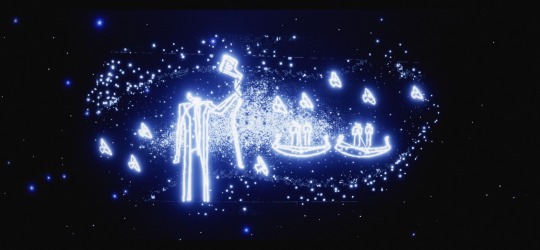
Birth. Nascence. The first establishment of existence. The Isle of Dawn is aptly named, being the first point of contact of the people that fell from the stars. They came on ships of stone, riding the newborn winds into this uncharted land, hoping to eventually settle. Pictures drawn of light can be seen carved out of the walls, a primitive method of documentation akin to cave paintings in the earliest times of our own society.
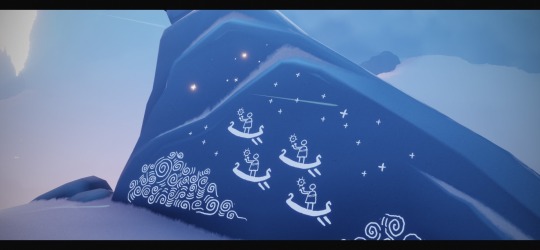

Remnants of the ships can still be found throughout a number of the lands, but especially so here, buried in the sands. The spirits that can be found here are identified as voyagers and stargazers - sailors making land for the very first time.
The elder of the Isle, Daleth, carries a cane, which is significant enough to make up the isle’s constellation. Perhaps they are like a shepherd, guiding the people to their new beginnings. Perhaps the cane just looks really, really cool.
The emotes learned here are directional, like pointing and following.
Part the Second: The Daylight Prairie
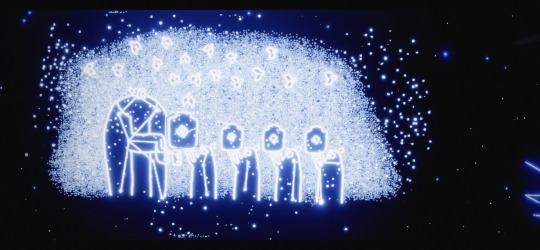
They locate the prairie, which signifies childhood. The flowers and the butterflies of light are in abundance here, symbolizing the purity and innocence of youth still untouched by society.
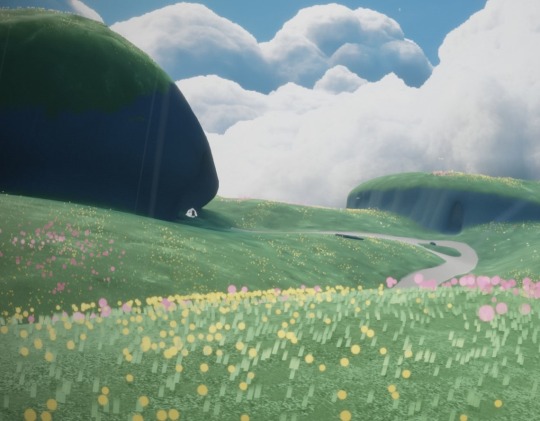
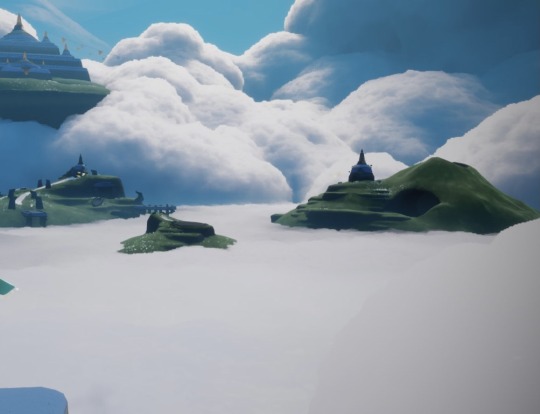
Here, the society is still in its infancy. The people see the untapped potential in this land, and they begin to plant their roots. Any notable settlements are still small and scattered, but supply lines are quickly established via boats carrying large pots across the clouds. The pots seem to be full of light, a valuable resource that several spirits here can be seen gathering and transporting.
The elder of the Prairie, Ayin, is also pictured as a worker of some kind, and they are depicted with a pot of light, hence the constellation’s shape. The transporting of light is critical to the continued development of the civilization.
The emotes learned here are very basic (like learning to wave hello) or childlike (like charming butterflies or laughing), among a few others.
Part the Third: The Hidden Forest

The forest is a symbol of adolescence: it’s a seeking of identity and all the growing pains it entails.

This light painting (the last one the can be found in the game’s progression [I think], another sign of the advancement of this people) shows the population carrying themselves deeper into areas of richer resources to further expand. And expand they do!

Their structures grow larger and more sturdy. Additionally, the doors through each wall are made of iron and small crystals of....blue light? A similar blue to that of the strange plants that can be seen growing everywhere. These plants of darkness seem to be appearing in larger numbers now: there were zero in the Isle of Dawn, and few enough in the Daylight Prairie that they’re easy to miss. Here they’re not rampant, but they are starting to command attention.
The darkness isn’t necessarily an absence of light, but rather an antithesis to light: the two are opposites but equally powerful in their own unique ways, and both can be seen in the forests’ constructions. There is also some evidence that darkness literally spreads through negative emotions such as hopelessness and sadness, as shown in the memories of the Tearful Light Miner:

While their crew is mining, there’s a cave-in, and all of their friends are injured by the falling rocks. One friend survives the initial collapse, but they are mortally wounded by the affair. This scene here could be their friend resigning to their unavoidable death, and their hopelessness manifests itself as a darkness plant growing out of them. A small detail which is only symbolically important, but tucks itself into the meta quite nicely later.
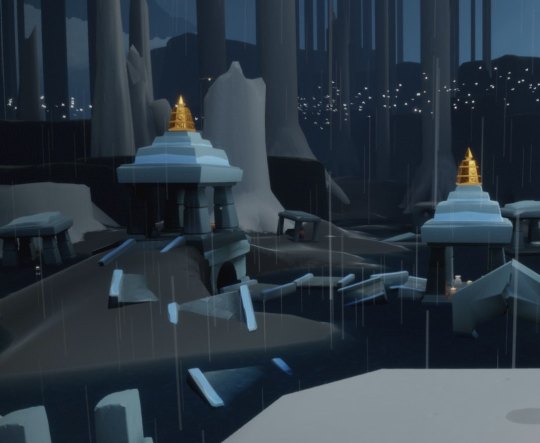
Returning to the story, the big theme here in the forest is industrialization. Lumberjacks, miners, prospectors, and pioneers can all be found here, striking their claim on this new soil and its resources aplenty. Structures are larger and more numerous, but at the cost of deforestation and putting a lot of holes in the cliffs for mining. Butterflies are not as common now, so alternative sources of light had to be found (more discussion about the harvesting of light from the light creatures can be found here in this post, and it’s this post that in fact inspired this entire post of my own).
Both light and darkness are being harvested from the earth (and possibly even synthesized, if the negative emotions becoming dark plants is taken literally) and fashioned into tools and machinery. The elder of the Forest, Teth, is a blacksmith, and the constellation is a hammer and anvil, a testament to the people’s industrial revolution. Their temple itself is a massive piece of machinery, an impressive feat of engineering only indicative of a civilization accelerating its growth and advancing towards a golden age.
Coincidentally, this oncoming of darkness is also reflected in the emotes learned here, such as apologetic, anger, worry, and crying.
Part the Fourth: The Valley of Triumph
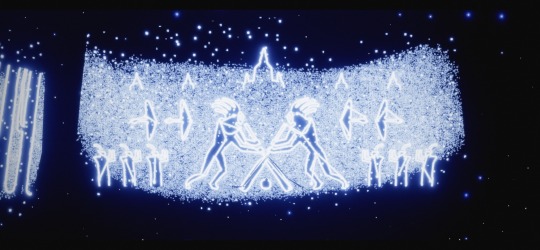
The Valley of Triumph symbolizes young adulthood and is the pinnacle of this society’s achievements. Buildings and structures here are HUGE: entire cities, castles, and the technological advancements are like nothing anyone’s ever seen.
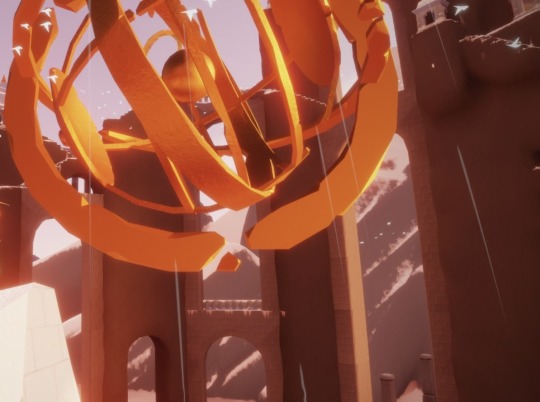
Here the populace has put less focus into expansion and more into the development of its culture. The architecture is much more colorful and stylized. Sporting events such as the races down the slopes or through the clouds are means of entertainment. The citadel’s orrery could indicate a deep understanding of astronomy and mathematics.

There are twin elders in the Valley: Sah and Mek, and they’re athletes! Whatever sport it is they play involves the use of long sticks, and it’s their two crossed sticks that make up the constellation, emphasizing the establishment of life’s greater pleasures and a thriving culture. A lot of the spirits found here are either athletic in some capacity or are out here living their best life.
The emotes learned here are of pride and athletic ability. Cheering is also noteworthy here, as happiness and enjoyment are highlighted in this realm.
The most curious part of this realm is that there are no darkness plants to be found, and I think the reason for that is that the populace is so swept up in its shows and studies that it’s distracted from its inevitable collapse that will soon follow. Perhaps these people don’t realize what is coming. So what is coming?
Part the Fifth: The Golden Wasteland

The Golden Wasteland symbolizes late adulthood, maybe even a sort of midlife crisis. It’s in this stage that the society begins to break down. The reasons for the upheaval are part of the game’s unsolved mystery, but there are some details of note to be highlighted in this realm.

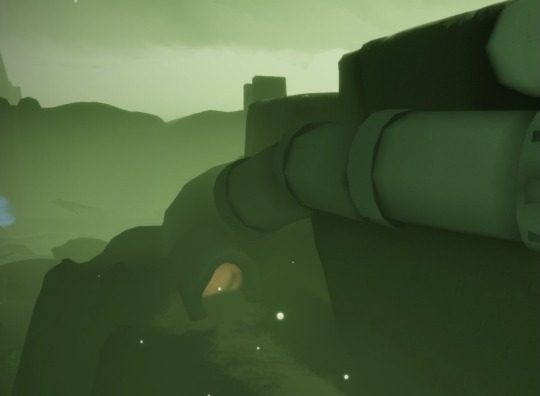
The structures here are the biggest we’d seen so far, and many of them are a lot like strongholds: Huge, thick walls; pipes of awesome size; and what used to be giant columns dot the sandy wastes. The water is polluted beyond purification; bones of large, long dead creatures are scattered across a hunting ground; and not only are darkness plants in abundance here, but an entirely new embodiment of darkness is also introduced: the krill.

Krill are a curious creature: not much, if anything, is known about their origins, but their presence as active seekers and destroyers of light could symbolize war and hatred, as an angry or upset individual would try to drag down others from feelings of happiness to the alternative. It is easier to succumb to the darkness and fall from light than it is to climb back out, and it appears that’s what this civilization has done.

In their pride and vanity, political disagreement had sprung into full-scale battles and skirmishes. Barricades pepper the land, especially just outside the temple. The people resorted to weaponizing darkness and blotted out light altogether (notice how fewer candles can be found here than in other realms). The world drowned in despair which only spread the darkness faster. It was like a nuke that left fear and anger in its wake with no chance for light to flourish again. All that remains now are the skeletons of stone and bone, memories of a dying people.
The elder here, Tsadi, is a warrior of renown strength, proficient with the constellation’s shape: a spear and shield. They likely fought along the barricades just outside the gates, desperate to protect any survivors that made it inside.
The spirits here are fighters, survivors, people that are struggling to stay alive in the chaos, and their emotes match that.
So, after this civilization burned itself to the ground, what remained?
Part the Sixth: The Vault of Knowledge
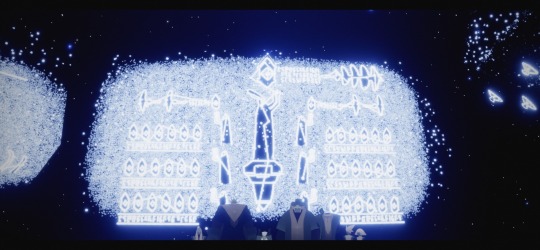
The Vault of Knowledge symbolizes old age. With no more strength and no more people, all that remains is the collection of knowledge they had accumulated throughout their history, from the Isle to the Wasteland, and any lessons that could be learned from it all.
The realm itself is one giant structure: a tall tower packed to the brim with knowledge stored as light. Light is in abundance here: it fills the room as you climb it, and memories of mantas and other light creatures dwell within here as well. There are little bits of buildings, floating platforms, and large skeletons on display, almost like a museum of the world that once was.
The elder here is Lamed, and the Vault’s constellation resembles a codex: one of the many lanterns found throughout the vault where texts are kept. In their cutscene, they appear tired and hopeless. The Vault is all that’s left between the source of the darkness and the rest of the world.
Scholarly spirits walked the halls and recorded as much history as they could before they too were wiped out by the impending darkness, vainly hoping that their mark on the world would be left behind in the stories they told so that they might not be forgotten. The emotes learned here are of praying and meditation, strongly suggesting the theme of pausing and reflecting on all that had transpired.
It is here that your journey begins to come to an end as you reflect on the realms that you’ve seen and the people you watched rise and fall. They weren’t forgotten because you witnessed it all. They succeeded, in a way.
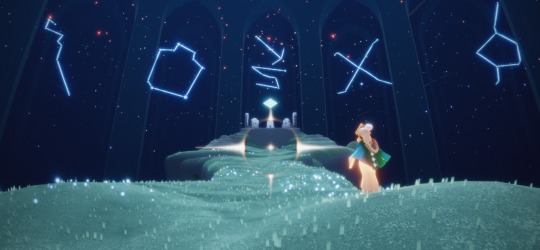

The Vault of Knowledge is unique in that at the top of the level, not just one elder statue sits, but all SIX are there. This realm isn’t a part of the society’s story: it IS the story.
As you progress through the level, the constellations are revealed to you, one by one.
In the cutscene where all six elders bow to you and thank you for guiding the spirits home, a song plays. What’s the official title of that song in the soundtrack?
“The Story So Far.”
Lamed and the other elders told you their story. About the rise and fall of their people, blinded by ambition and by a thirst for both light and darkness. In their attempt to balance the two powers, darkness ultimately won, and now no one remains.
Only a vault. The room of six statues is a new addition, as they all seem cleanly cut and without any wear. They were built intentionally, shortly before the darkness destroyed everyone, as a means to tell that story to whomever may find them.
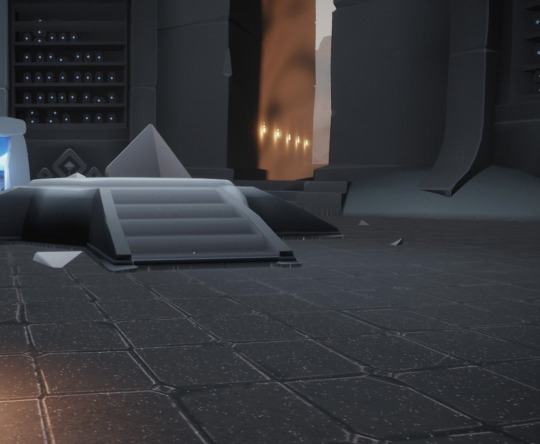
This was the old room. Where Lamed’s statue once stood is now an empty pedestal. The light is now gone, and the soft blues and blacks of the rest of the level are now a dark, dull gray. The only decent source of light is from the occasional flashes of lightning from the storm beyond. The rest of the Vault was sealed off to protect its contents and its people who all died within, leaving this top chamber to be consumed.
Finale: The Eye of Eden
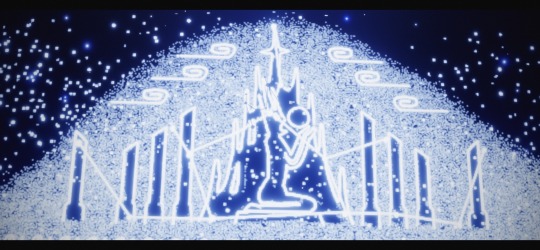
The most mysterious of the seven realms, Eden symbolizes death, an inevitability for all. I don’t have a lot to go off of for this part, but the red diamond that rests at the top of the mountain seems to be neither light nor darkness. It’s emitting a ray of golden light up to the heavens, but it’s also showering the mountain in a dark storm of rocks. So, which is it?
The scene shown from the Vault cutscene depicts the mountain with the diamond at the top. There also sits a monarch of some kind underneath it. Is this king the one that weaponized darkness and brought the fall of his people? There’s a lot of speculation behind this one.
I believe the diamond is death itself. Death is the most powerful tool a king can have, for there’s no threat to your power if all your competition is in the ground. But a warmonger invites violence to his doorstep, and he and all his people perished as a result.
But the diamond itself is not to be feared. Yes, it’s spouting darkness across the land, and that’s all a mortal will ever see. But on the other side of that dark storm is the beam of pure light shooting into the heavens, something only the deceased will embrace and understand. Death is an ending. Death is a release.
The spirits all needed a little light to find their way to that other side. So you lit them with your candle. You taught them how to feel love and happiness again, something that widespread darkness took from them.
And when you fell and collapsed under the darkness yourself, some other sky kid came along and granted you their winged light so you may pass on too.
And you and the spirits, now freed from the suffering of darkness by way of just a taste of light, returned to the stars from whence you came.
....Uhh, the end? That’s my super hot take? Add to it if you like?
#sky children of the light#sky cotl#sky spoilers#eden spoilers#long post#sky headcanon#sky theory#hey uhh hi skyblr#it's nice to meet y'all#feels good to finally contribute proper
99 notes
·
View notes
Text
ok this took way longer than i expected because i got sidetracked looking at paintings and reading poetry and just admiring the mv, but it's finally finished!! let's talk about
higher
✨
i'm going to draw your attention to a few things.
firstly, these verses from rime of the ancient mariner by samuel taylor coleridge, published 1834:
The harbour-bay was clear as glass,
So smoothly it was strewn!
And on the bay the moonlight lay,
And the shadow of the Moon.
The rock shone bright, the kirk no less,
That stands above the rock:
The moonlight steeped in silentness
The steady weathercock.
And the bay was white with silent light,
Till rising from the same,
Full many shapes, that shadows were,
In crimson colours came.
A little distance from the prow
Those crimson shadows were:
I turned my eyes upon the deck—
Oh, Christ! what saw I there!
Each corse lay flat, lifeless and flat,
And, by the holy rood!
A man all light, a seraph-man,
On every corse there stood.
This seraph-band, each waved his hand:
It was a heavenly sight!
They stood as signals to the land,
Each one a lovely light;
This seraph-band, each waved his hand,
No voice did they impart—
No voice; but oh! the silence sank
Like music on my heart.
secondly, this ivan aivazovsky painting, chaos (the creation), c. 1841:
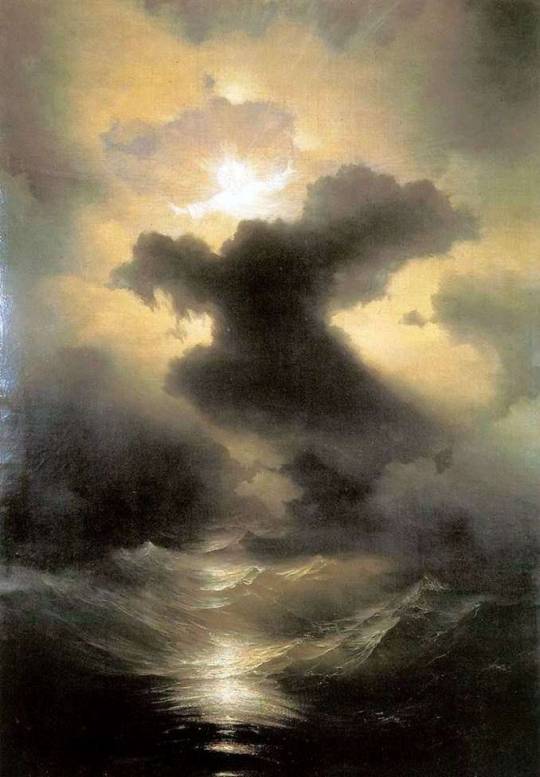
and thirdly, the memorial of percy shelley, who drowned in a boating accident at age 29, in 1822:
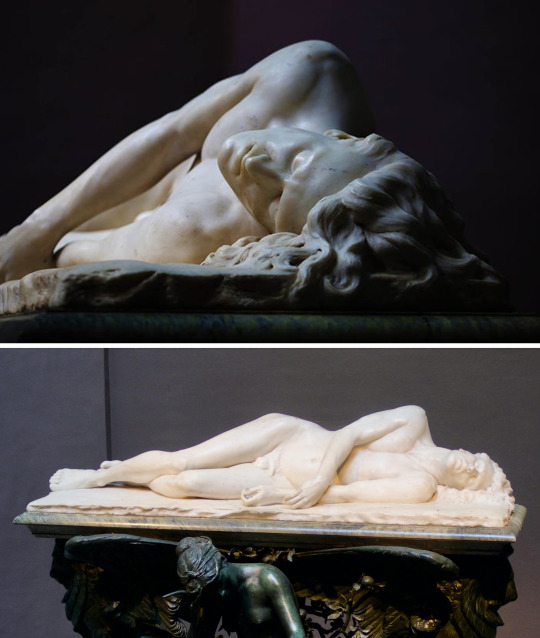
there's a common conflation between the romantic and the pastoral in the general cultural consensus because the pastoral a) has been around as an art term longer than romantic, and b) romanticism does use some similar imagery. but there is a key difference: the pastoral is specfically an idealization of 'the simple shepherding life,' often for high class and urban audiences who have no conception of the details of this life includes. one of the more famous examples is christopher marlowe's a passionate shepherd to his love, published in 1599:
Come live with me and be my love,
And we will all the pleasures prove,
That Valleys, groves, hills, and fields,
Woods, or steepy mountain yields.
And we will sit upon the Rocks,
Seeing the Shepherds feed their flocks,
By shallow Rivers to whose falls
Melodious birds sing Madrigals.
And I will make thee beds of Roses
And a thousand fragrant posies,
A cap of flowers, and a kirtle
Embroidered all with leaves of Myrtle;
A gown made of the finest wool
Which from our pretty Lambs we pull;
Fair lined slippers for the cold,
With buckles of the purest gold;
A belt of straw and Ivy buds,
With Coral clasps and Amber studs:
And if these pleasures may thee move,
Come live with me, and be my love.
The Shepherds’ Swains shall dance and sing
For thy delight each May-morning:
If these delights thy mind may move,
Then live with me, and be my love.
whereas romanticism is a more pointedly specific movement that was active from around 1800 to 1850, primarily focused on intense emotion and catharsis as the primary experiential output of an artwork. which most prominently manifested in a deep fascination and glorification of the natural environment and historical nostalgia. the movement sprung from the german sturm und drang (literally storm and drive/stress) period of the late 1760s to early 1780s, which was a direct reaction to rationalism and enlightenment. romanticism had similar impulses; it was also a revival of medievalism and a reaction against the looming urban sprawl and mechanization of the industrial revolution. a typical romantic poem from one of the originators of the english movment william wordsworth, composed upon westminster bridge, september 3, 1802, originally published 1807:
Earth has not any thing to show more fair:
Dull would he be of soul who could pass by
A sight so touching in its majesty:
This City now doth, like a garment, wear
The beauty of the morning; silent, bare,
Ships, towers, domes, theatres, and temples lie
Open unto the fields, and to the sky;
All bright and glittering in the smokeless air.
Never did sun more beautifully steep
In his first splendour, valley, rock, or hill;
Ne'er saw I, never felt, a calm so deep!
The river glideth at his own sweet will:
Dear God! the very houses seem asleep;
And all that mighty heart is lying still!
this romantic fascination with nature was underpinned by the philosophy of the sublime, generally agreed to be first treatised by edmund burke in 1756, the theory was also written about by kant and hegel. in the simplest of terms, the sublime is a quality of greatness beyond calculation, imitation, and human comprehension. the sublime is twofold; the greatness of the ocean is beautiful, but its power is also terrifying, and the experience of the sublime is to feel those two at once. to be in awe and also to be horrified of its ability to sink ships and drown a life in a tempermental change of tide.
let's take a quick detour to talk about
clothing
in the present day we have become much more lax thanks to the aesthetic movement in the late nineteenth century, but back in the early victorian period there are still highly structured rules about when and what clothing one can wear in public. and the clothing itself is also highly structured. anyone with a passing understanding of the victorian era knows about the whole flashing of the ankle thing and corsets galore, and it is true that the general day to day garments cover a lot of area. for men in particular, this manifests in no less than three layers in public at all times: shirt, waistcoat, and suit jacket, with a coat or mantle overtop in colder temperatures. this also includes a variation of a neck tie (depending on what year), hat, gloves, and any other decided upon accessories (this can also include a corset and other padded structural underpinnings).
an important tangent to mention here is that this is the uniform of the upper classes, although the rules do apply to the lower classes if they wanted to appear 'sophisticated.' the working man's uniform was also shirt, waistcoat, trousers, but the difference here is in the textiles themselves; the colours tended to be much more drab, with less complicated patterns. obviously due to the price fabric itself, but also due to the labour of laundry. an indicator of class here is the white shirt itself and its pristine implications. (there is a longer conversation here about the invention of neckties and detachable collars and cuffs, but that's for another day).
the silhouettes are very important to note here in the higher mv, as they are directly referential to the 'romantic poet' archetype of loose shirt and tight pants that we see in popular culture. but as i've just said, the reality is that men of the era were not dressed like this out in public. this look is essentially underwear; the implications are salacious. so where did this come from? well, we can blame it mostly on lord byron, who by all accounts was the first western 'rockstar.' notoriously called 'mad, bad and dangerous to know' by lady caroline lamb (a married women he publically had an affair with), byron was openly bisexual and deeply hedonistic with a lot of questionable habits, but his poetry was so popular that he was known to have women following him in the street and gathering in large quanities to see him at salons. and this was close to three decades before lizstomania. his close friends and contemporaries included percy and mary shelley, with whom he lived with abroad in italy for some time (this living arrangement resulted in the writing of both frankenstein and john polidori's the vampyre). byron's reputation was so eclipsing that the image of the lush poet lazing in his undergarments has become its own genre of romantic, slightly removed from the movement byron was writing in. it's also worth it to point out that there are no official portraits of byron dressed like this from the time. the visual assumption is somewhat apochryphal.
now let's get into some specifics. a.c.e is not unfamiliar to this silhouette; as previously mentioned in this post i wrote about their styling, the boxy loose upper and fitted lower is their general mode for their styling because of its emphasis on legs. cactus was the most extreme example of this, and to prove my point, this specific silhouette is extremely common in classical ballet:
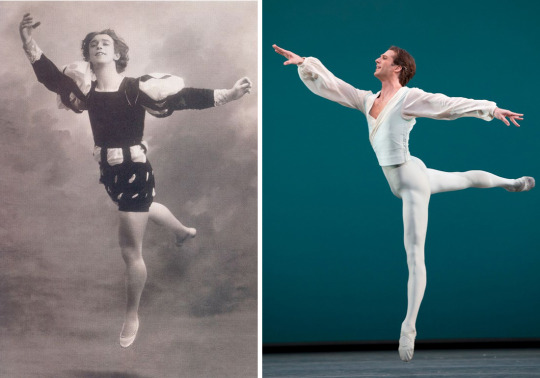
1. vaslav nijinsky, giselle, 1911
2. nehemiah kish, george balanchine's ballo della regina, 2011/12
higher fits very neatly into this same category: we have an emphasis on the legs through tightly fitted garments and also through light reflective textile, as well as a secondary emphasis on arm and shoulder movements with looser fit shirts. plus, the shirts are made from fabrics that have good drape and flow, and mimic the visual effects of water:

there are also several instances of scale patterning and wetlook hair styles, further elabourating on the siren theme. and the jewelry is the same, purposefully cut clear stones for oceanic sparkle or pearls, the gem directly born from water, as highlighting accents to specific parts of the body - namely eyes, hands, and torso:

the body jewelry also serves a double purpose in addition to being sparkly; it gives a semblance of shape to their torsos so their movements aren't totally lost in the shroud of their shirts, and it also invokes some of that salacious element that us as a modern audience doesn't necessarily perceive in the same way when we see a man wearing only a shirt. all of these points are especially prominent in the stage costuming. concerning the veils, these are an aesthetic choice following the theme of depicting water without actually using water. the song has a very breathless quality to it, and the lyrics directly make reference to water and breathlessness, so it only makes sense to have a physical manifestation of struggling to breathe.
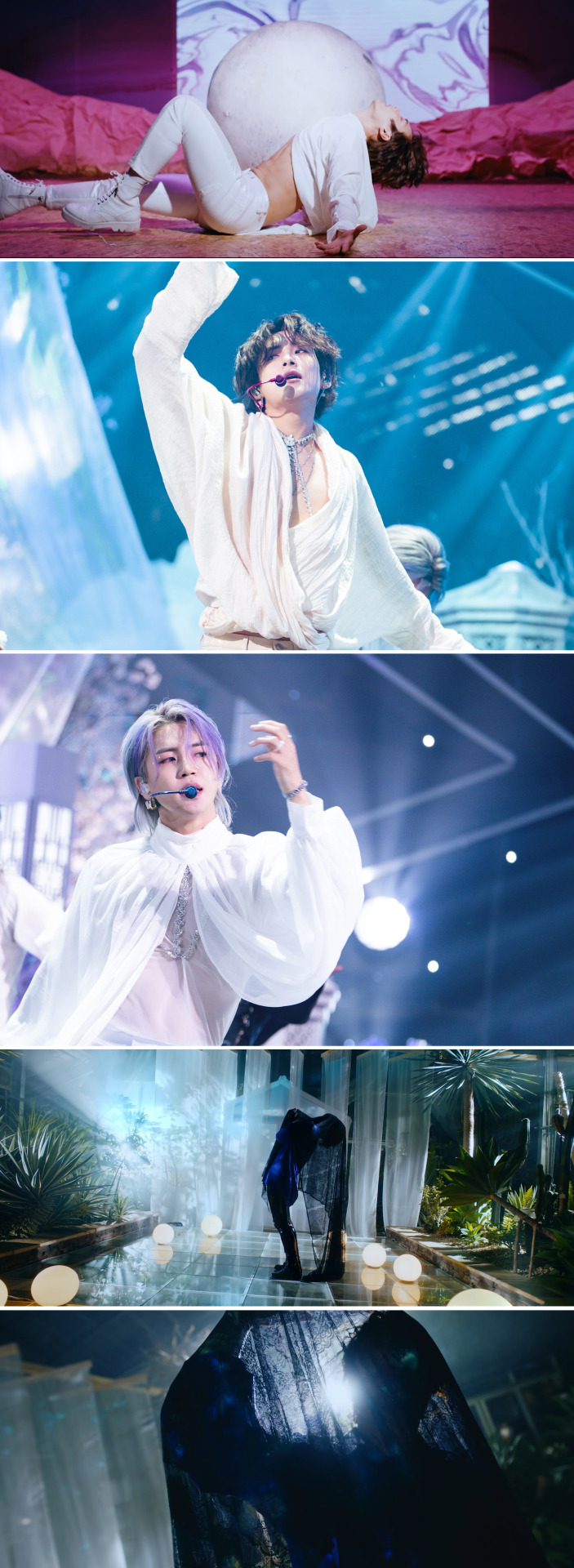
now let's talk about
mise-en-scène
unlike most kpop mvs, I would argue that higher is not a spectacle in what we normally see spectacle to be. the overwhelming visual saturation of goblin (and the goblin remix) is more in line with what we expect, but how do you follow that, top it? the answer is that you don't. you aim for something with a completely different feel, which is exact what they did with higher.
the performing arts did not escape romanticism. the very start of the movement, sturm und drang, is actually named from a specific play written by friedrich maximilian klinger that premiered in 1777. the plays of the brief period are characterized by extreme and passionate emotions, and were siblings to one of the most famous genres of theatre, the melodrama. meant to appeal directly to the emotions of the audience using sensationalist plots and stock characters, the melodrama was the predominent form of entertainment in victorian england and gradually developed a specific form of its own. in this period we also start to see the development of 'stagecraft' into the recognizable form that it takes today. footlights, limelight/spotlighting, the separation of house and stage lighting, fly galleries, elevator platform mechanics, and the first (purported) western use of rear projection are all innovations of the late 18th and 19th centuries, as melodramas were known to have very intricate and spectacular stagings. and to go along with these stagecraft mechanics we see the rise in designated stage crews, which were predominantly off-duty sailors looking to make money. the rope systems that made up the fly galleries were very similar to that on ships, and much of the terminology and supersitions crossed over: this is the origin of the term 'rigging' being used for suspending set elements, and also the origin of the 'don't whistle in a theatre' superstition. as sailors communicated with whistle patterns on ships, the same system was adopted for changing scenery, and therefore whistling a random pattern could potentially drop a setpiece on an unsuspecting victim.
so with all this backstory out of the way, what is the very first full location we see? a stage, complete with forced perspective via the painted fabric legs (the side panels) and borders (the wavy upper panels). we even have a flat painted backdrop with a projection screen and hanging overhead lamps. there's also a second interior set, a desk in what looks to be a study of some kind. bit self explanatory on this one, taking the poet notion on the nose.

the locations have a bit of an obtuse arc, but it's there when you look for it. it starts interior spaces, where the ideas of sublime attempted to be recreated for the viewer. then it moves to transitory spaces; portions of nature isolated from a whole environment, interjections of human architecture into natural spaces:
(the white hut structure in the greenhouse is reminiscent of a skene (literally hut/tent), which is the structure at the back of the stage in ancient greek theatre used for the actors to change their masks and costumes. it was originally temporary, but slowly transformed into permanent stage architecture)

and then finally outdoors, into the sublime itself:

jwm turner, crossing the bridge, 1815
lastly,
lighting
there's a very clear lighting pattern here, primarily in light and dark. the base colour story is fairly simple complementary pairs; there's a lot of purple/red and green, and blue and yellow/amber, with everything relatively on the same tonal level. there are deliberate interjections of heavily saturated red for specific effect. there are also, most notably, a 'dark' version of all the sets. obviously as a reference to the eclipse that we see in the mv and in the concept photo series, but also as a reference to that darker undercurrent of the sublime, the upsetting, the uncanny, and the terrifying:

And the bay was white with silent light/Till rising from the same/Full many shapes, that shadows were/In crimson colours came.
#a.c.e#ace w#kpop analysis#group analysis#me - a staunch defender of kpop as valid spectacle: actually this one is a melodrama its meant to hit different#this essay is otherwise known as the quickest and dirtiest history of romanticism ever#i really should have pointed out that when i say romantic i mean romantic with a capital r#that probably would clear up some confusion but i have an aesthetic to maintain do not @ me#this is potentially the most pretentious thing i have ever written i am so sorry if this makes no sense#some of these connections are so tenuous who let me have opinions on the internet#did i write this as an excuse to look at the percy shelley memorial because i am obsessed with it as a piece of art? maybe#anyways read tom stoppard's arcadia if you want to know more about that#you should read all this with the caveat that the sublime and romanticism need to be deconstructed through a postcolonialist lens#because these theories are super colonialist about 'unclaimed untameable natural spaces'#when in reality most natural spaces are specifically architected by indigenous peoples in order to preserve and coexist with the ecosystem#this is may be more obviously applicable to american subliminal painting than european but it still applies#since the british were notoriously good at fucking up every kind of expedition ever#because of their lack of respect for literally anything and everything#and their inability to listen to anyone other than another white british person#see: history of the northwest passage#im a bad theorist and not caught up so i didnt get that deep into it because counter to the wordcount#i am not trying to write another dissertation#this is not as well researched as it could be but also im not reading burke and kant again#also yes byron the shelleys and polidori did just bang out the foundations for all of science fiction and romantic vampire mythology#in like three days because the all got bored during a storm and want to try and 'outscare' each other#also by 1840 like every prominent romantic poet was dead either from their own stupidity or tuberculosis#with the exception of wordsworth that motherfucker started the movement and then outlived it#text
17 notes
·
View notes
Text
Prog-Doom Trio APE VERMIN Blast New EP, 'Arctic Noise’
~Doomed & Stoned Debuts~
By Billy Goate

Album Art by Steven Yoyada
One of the most impressive release years on record was 2018, when all the big dogs of doom dropped new albums. It was a tough year for a fledgling band to make its big splash, but somehow APE VERMIN made us all turn around and take notice, birthing a massive full-length debut 'Sonic Monolith' (2018) -- still a favorite among doomers. Now, we herald the return of the North Carolina heavyweights with an extended play record, 'Arctic Noise' (2021).
Having already crossed the 2-3 year threshold that seems to either make or break many a promising band, Ape Vermin seem here to stay as they near a half-decade together. Originating in 2017, Brett Lee (guitar, vox), William Deal (bass), and Charlie Burleson (drums) dub their style progressive doom. Through firmly grounded to the storied tradition of deep, reverberating doom, these guys are explorers who like ancient man simply are searching for new horizons.
“Our records are stepping stones for us,” frontman Brett Lee states. “We put our heart and soul into them and where Sonic Monolith had a very drone-type feel with an avalanche of groove, this new EP is a little more over the edge, and more melodic at times. We wanted this EP to represent the celebration of echo, death, and rebirth.”
Based in the small town of Valdese with barely 5,000 souls to speak of and nestled near the Catawba River 'neath the looming mountains, Ape Vermin have developed a club weilding style that's also surprisingly spiritual. Their bio depicts their artful style as comp[ose of "juddering riffs, thundering drums and otherworldly concepts that underpin the sheer mania of their music, along with hypnotic riffs and nimble fretwork" which gives"genuine virtuosity to the sonic vistas they create." That, my beloved Doomers & Stoners, I can firmly endorse.
And now to the record before us. We first encounter on Arctic Noise a song called "Megaliths Of Echo." Warping pedal effects and feedback are interrupted by a declamatory guitar lead accented by bass and drums, establishing our main theme. If you listen carefully, a story is being told in the music alone. Chugging riffage erupts with a stampede of rhythm bringing us caveman-like grunting, "Arctic Drone! Asteroid Explode! Shadow! Behold! Echo! Unfold! Astral Fate, Colossus Awake!"
Something momentus has happened, and suddenly the mood shifts down to a Cathedralesque riff that reminds me of that chilling moment on "Tower of Silence" when Lee Dorian announced, "The circle of time has stopped...sun no longer shines." And we're but five minutes into this gigantic near 17 minute slab of ice core.
Fire in the arctic!
To celebrate this guilt.
We've been surrounded,
By the ice!
We've killed the martyr,
to set free this realm.
We've been surrounded,
By the ice!
Fire in the arctic!
We've been surrounded!
We've killed the martyr!
The stone has fallen!
It's clear that someone's doom has come. For a moment, you can see it in your mind's eye, perhaps a churning in the gut, as the Neanderthal DNA still abiding inside has a sudden flashback to this momentous day in prehistory. What is happening? No one knows. Confusion abounds. All one can do is stand, watch in awe, and contemplate their fate.
We fade in the end,
You've been holding the earth,
We've been mining the sun,
You will fade in the end.
I talked last night to frontman Brett Lee, who shared: "These songs were written during an intense emotional period." You can see the lyrics both describing some long ago fantastic calamity and also doubling as a metaphor for the bewilderment that comes with change and uncertainty, which all of us know far too well in recent days due to pandemic pandemonium.
Open the door,
To find reason to kill,
Locked up inside,
For 10,000 years.
Something is encased in ice, and thawing. An ancient spirit lies within with the raw instinct for survival. It grabs us in our weakest moments and shouts, "Live, god damn, you, live!" The emotion laden writhing of the axeman seems to stir up such sentiment as I listen. Then a reminder of my own mortality.
We fade in the end,
We echo.
We have such a short time to live. Our time is now. Let's attack it with the same uncouth gusto of our forebears, who struggled to survive in the ice and snow. The words of Led Zeppelin's "Immigrant Song" comes to mind in these closing minutes:
We come from the land of the ice and snow
From the midnight sun where the hot springs flow
The hammer of the gods
Will drive our ships to new lands
To fight the horde, sing and cry
Valhalla, I am coming

Ancient Ruin takes the stage next, with a Near Eastern sounding motif with an attractive hook accompanied by tribal beat and voices singing in Forming The Void like harmony, "Orion." Following this is a vicious drum dominant slog and once again, we hear from our gruff caveman, who exclaims:
Fading out, Cosmic temple
Riding out of this hell
fear thy brother, meet thy maker
Feel the darkness in my soul.
It's clear a religious ritual of some sort is underway, perhaps in response to the inexplicable disaster of the opening number.
We finish our adventure with the namesake track, Arctic Noise, which could very well serve as a Part B to the previous song. The riffage here seems more curious and wandering. A tale is told 'round a cave sheltered camp fire as cold, vicious winds blow about.
Arctic samurai, Astral vision
May the arc of life BURN!
Ancient avalanche echo
All hail noise
I am the wretch
I am the fiend
Out of the void and in the machine
I am the failure
I am the one
Out of the rapture and into the sun.
A searing solo breaks through that reminded me of one we'd hear on the first High on Fire record, only it begins feeling kind of wobbly and wounded, as if in pain. It quickly becomes seized by adrenaline and expresses itself in a confident, warm-blooded tone. I haven't said enough good things about the drumming so far, but it really shines in the second half of this song, and of course William Deal's basswork is as hearty as ever. The song ends on a cliffhanger, as if to say: "To be continued."
"I leave a lot of imagination in the lyrics," Brett told me, but dispels any notion that this is thematically linked to their debut LP, 'Sonic Monolith' (2021). He ended our conversation with an intriguing footnote: "Although deep in the lyrics in the debut album and also this E.P may you unlock what is to come next!"
Next did you say? That's something to look forward to, for damn sure! What better time than now to become a fan of Ape Vermin and revel in their dirty, gritty doom and fuzz-loaded stoner vibe!
I would be remiss were I to compliment the extraordinary album art by Steven Yoyada (who also penned the remarkable cover for our recent Doomed & Stoned in Denver compilation). Gaze upon this moment frozen in fantasy and you'll discover that it, too, has captured something of the record's soul.
Arctic Noise by Ape Vermin will be officially see the light of day on May 7th via Koloss Records (pre-order here). Fans of Conan, High on Fire, and Mastodon are you listening? Good, because Doomed & Stoned is rocking this mother in its entirety today.
Give ear...
Arctic Noise by APE VERMIN
Follow The Band
Get Their Music
#D&S Debuts#Ape Vermin#Valdese#North Carolina#doom metal#sludge#metal#heavy metal#progressive doom#Koloss Records#D&S Reviews#HeavyBest2021#Doomed and Stoned
12 notes
·
View notes
Text
Solar System playlist

Look up!
It’s a bird!
It’s a plane!
It’s....the Solar System playlist.
Click play here: https://www.youtube.com/playlist?list=PL-iHPcxymC18LD_V5saMr7QzWS1Q3VAU6

What’s out there beyond our own planet?
A mystery at every turn. Mercury to Pluto. The Sun and the Moon, even Phobos gets a mention here.
So come by the Neptune Towers and enjoy this Solar System playlist.
SOLAR SYSTEM
001 Amorphis - Far From The Sun
002 The Beatles - here comes the sun
003 Swans - Song For The Sun
004 Mastodon - Once More 'Round The SunStiff Little Fingers
005 Soundgarden - Black Hole Sun
006 Isaac Hayes - Driving In The Sun
007 Tom Petty - dark of the sun
008 DREAMTIME - Sun
009 Circus Diablo - Red Sun Rising
010 Tiamat - The Sun Also Rises
011 Covenant - Bringer of the sixth sun
012 Agoraphobic Nosebleed - hung from the rising sun
013 Alice in Chains - When the Sun Rose Again
014 Lindemann - Children Of The Sun
015 Paradise Lost - Return to the Sun
016 Popol Vuh - Morning Sun
017 Spiritual Beggars - Blood Of The Sun
018 Queens Of The Stone Age - My God Is The Sun
019 TREMENTINA - Kisses in your eyes (Almost Reach The Sun )
020 Voivod - Divine Sun
021 Blues Pills - Little Sun
022 Neurosis - Enemy of the Sun
023 Extol - Behold The Sun
024 Septic Flesh - Infernal Sun
025 Lamb of God - Straight For The Sun
026 Ensemble Economique - Red For The Sun
027 Black Sabbath - Under The Sun
028 Jesu - Opiate Sun
029 Orchid - Into the Sun
030 The Young Gods - Kissing The Sun
031 Iron Maiden - brighter than a thousand suns
032 Swans - I Am the Sun
033 Therion - Son Of The Sun
034 Sun Ra - Sun song
035 Pink Floyd - eclipse
036 Mike Patton - Eclipse Of The Sun
037 Bonnie Tyler - Total eclipse of the heart
038 God Is An Astronaut - First Day Of Sun
039 Elton John - Don’t let the sun go down on me
040 Eddie Fisher - Sunrise, Sunset
041 Hopscotch Songs - The Planets of our Solar System Song
042 Michael Schenker Group - Blood Of The Sun
043 Iron Maiden - total eclipse
044 Solefald - Sun I Call
045 Man or Astro-Man? - Antimatter Man
046 Kreator - when the sun burns
047 Creedence Clearwater Revival - bad moon rising
048 George Harrison - beware the darkness
049 Heretoir - To Follow The Sun
050 Cat Stevens - Moonshadow
051 Hypocrisy - Adjusting the Sun
052 Rush - Between Sun & Moon
053 Manfred Mann - blinded by the light
054 Sevendust - Black Out The Sun
055 Sunbeam Sound Machine - Real Life
056 Bill Withers - Ain’t no sunshine
057 Gwar - They Swallowed the Sun
058 Katatonia - Ghost Of The Sun
059 The Beatles - I’ll follow the sun
060 Sammy Hagar - little eclipse/sunshine
061 Stevie Wonder - you are the sunshine of my life
062 Pink Floyd - fat old sun
063 Sun Ra - Sunology
064 Mystic Sunship - out there
065 Cream - sunshine of my love
066 Diesto - High As The Sun
067 Sunwølf - SOlar
068 Kyuss - Molten Universe
069 Moonspell - Shadow sun
070 Neurosis - A Sun That Never Sets
071 Therion - An Arrow From The Sun
072 Candlemass - The Killing Of The Sun
073 Xandria - Kill The Sun
074 Morgoth - Drowning Sun
075 Primordial - Wield Lightning to Split the Sun
076 Lake of Tears -When My Sun Comes Down
077 Jackie DeShannon - Where Does The Sun Go
078 Peter Criss - Down With The Sun
079 Walker Brothers - The Sun Ain't Gonna Shine Anymore
080 Devin Townsend - Midnight Sun
081 Sigh - Midnight Sun
082 Black Label Society - Dark Side of the Sun
083 AMORPHIS - Moon and sun
084 Cynic - Moon Heart Sun Head
085 Sun Ra - Planet Earth
086 David Lynch - Sun Can't Be Seen No More Sarah No More
087 Opeth - Moon Above, Sun Below
088 The Eternal - A Quiet Death of The Sun
089 High On Fire - The Sunless Years
090 The Jimi Hendrix Experience - Third Stone From The Sun
091 Bruce Dickinson - Navigate The Seas of The Sun
092 Voivod - Mercury
093 Melechesh - Of Mercury And Mercury
094 Gustav Holst - Mercury, the Winged Messenger
095 Clutch - Mercury
096 Soilwork - Mercury shadow
097 Satyricon - Mental Mercury
098 Moonspell - Moon in mercury
099 Poisonblack - Mercury Falling
100 Alejandro Jodorowsky, Ronald Frangipane & Don Cherry - Venus (Vond)
101 Boney M - Nightflight to Venus
102 Red Hot Chili Peppers - Subway To Venus Nihal Chahdi
103 The Nefilim - Venus Decomposing
104 Electric Wizard -Venus In Furs
105 Popol Vuh - Venus Principle
106 Bananarama - Venus Venus Mosquera
107 Apocalyptica - The Shadow of Venus
108 Archgoat - Sodomator Of The Doomed Venus
109 Ordo Rosarius Equilibrio - Phosphorus Ascending Anthem of Venus
110 Gustav Holst - Venus, the Bringer of Peace
111 Billy Idol - Venus
112 Boyd Rice - Between Venus and Mars
113 Dee D. Jackson - Venus, the goddess of love
114 Therion - Dark Venus Persephone
115 T-Rex - Venus loons
116 Television - Venus
117 Paul McCartney and Wings - Venus and Mars & Rock Show -
118 Theatre of Tragedy - Venus
119 David Bowie - Space oddity
120 The Byrds - Spaceman
121 To-Mera - Earthbound
122 Borknagar - Inherit the Earth
123 Devin Townsend - Earth
124 William Shatner - Planet Earth
125 Clutch - Earth Rocker Jen Rocker
126 DEVO - Planet Earth
127 Misfits - Earth AD
128 Les Baxter - Earth light
129 Louis and Bebe Barron - Come Back to Earth with Me
130 Tristania - Tender Trip on Earth
131 Joseph Arthur & The Lonely Astronauts - Lonely Astronaut
132 Voivod - Target Earth
133 Samael - Son of Earth
134 Billy Preston - Space race
135 Alice Cooper - Last Man On Earth
136 Agalloch - ...and the Great Cold Death of the Earth
137 Deep Purple - space truckin
138 Steve Miller Band - space cowboy
139 Crowbar - Liquid Sky And Cold Black Earth
140 Jesu - Mother Earth
141 Devin Townsend - Earth Day
142 Animals as Leaders - Earth Departure
143 Amorphis - Enchanted by the Moon
144 Goatsnake - House of the Moon
145 Elton John - Rocket man
146 Cramps - Rock On The Moon
147 The Stranglers - Rok It To The Moon (Bonus Track)
148 Frank Sinitra - fly me to the moon
149 Blood Ceremony - Drawing Down the Moon
150 Elvis Presley - flaming star
151 Les Baxter - The other side of the moon
152 In Flames - Moonshield
153 Ozzy Ozbourne - bark at the moon
154 Fields Of The Nephilim - Moonchild
155 Iron Maiden - Moonchild
156 Blue Oyster Cult - stairway to the stars
157 Voivod -Moonbeam Rider
158 The Black Crowes -Black Moon Creeping
159 Grand Magus - Silver Moon
160 AC DC - next to the moon Craig Norman
161 Manilla Road - fires on Mars James Daniel danke
162 Alejandro Jodorowsky, Ronald Frangipane & Don Cherry - Marz (Esla)
163 Entombed A.D. - Down To Mars To Ride
164 Grateful Daed - dark star
165 Orange Goblin - Return To Mars
166 Ascension of the Watchers - Mars becoming
167 Styx - come sail away
168 Faith No More - Woodpecker From Mars
169 Kreator - Mars Mantra
170 The Misfits - Mars Attacks
171 Gustav Holst - Mars, the Bringer of War
172 Judas Priest - invader
173 Electric Wizard - Priestess Of Mars
174 Queen - Flash Gordon
175 Stone Temple Pilots - First Kiss On Mars
176 Hoodoo Gurus - mars needs guitars
177 War Of The Worlds ~ The Eve of the War
179 Noble Jackals, Penny Dreadfuls and the Systematic Dehumanization of Cool - Mars Needs Women
180 Alice Cooper - Might As Well Be On Mars
181 Total Recall Jerry Goldsmith - First Dream (Total Recall)
182 Laibach -Mars On River Drina
183 Lantlôs - Neige de Mars
184 The Misfits - Teenagers From Mars
185 Voivod - Phobos
186 2001_ A Space Odyssey Theme Song (Also sprach Zarathustra)
187 Covenant - Planetary black elements
188 Killing Joke - Asteroid
189 Kyuss - Asteroid
190 Alejandro Jodorowsky, Ronald Frangipane & Don Cherry - Jupiter (Clen)
191 Blues Pills - Jupiter
192 Samael - Jupiterian Vibe
193 Earth Wind & Fire - Jupiter
194 Tumbleweed - Jupiter Aje Morris
195 The Cure - Jupiter Crash
196 Devin Townsend - Jupiter
197 Gustav Holst - Jupiter, the Bringer of Jollity
198 Celestial Season - Jupiter
199 KATAKLYSM - EMBRACING EUROPA
200 David Bowie - I Took A Trip On a Gemini Spaceship
201 Isao Tomita - Space Fantasy
202 The Misfits - Lost in Space
203 Gwar - Lust In Space
204 Alejandro Jodorowsky, Ronald Frangipane & Don Cherry - Saturn (Sal)
205 Älgarnas Trädgård - Rings Of Saturn
206 Electric Wizard - Saturn Dethroned
207 Les Baxter - [ Saturday night on saturn
208 While Heaven Wept - Saturn And Sacrifice
209 Ash Pool - On The Rings Of Saturn Adam And Eve Conceive Cain
210 Scott Kelly - Saturn's Eye
211 Gustav Holst - Saturn, the Bringer of Old Age Ximenenes Y. Zeroth
212 Samael - Born Under Saturn
213 The Devil's Blood -Everlasting Saturnalia
214 Stevie Wonder - Saturn
215 Circle - Saturnus Reality
216 R.E.M. - Saturn Return
217 The B-52's - There's A Moon In The Sky (Called The Moon)
218 Fu Manchu - Saturn III
219 National Geographic Space Kit - The Eerie Sounds Of Saturn
220 AYREON - To the Solar System
221 Voivod - Meteor
222 Alejandro Jodorowsky, Ronald Frangipane & Don Cherry - Uranus (Berg)
223 Klaatu- Anus Of Uranus
224 Arcturus - Kinetic
225 Gustav Holst - Uranus, the Magician
226 Cathedral - Suicide Asteroid
227 Movie Moment - Contact (First Contact) OST
228 Alejandro Jodorowsky, Ronald Frangipane & Don Cherry - Neptune (Axon)
229 Lisa Gerrard - Neptune
230 Neptune Towers - To Cold Void Desolation
231 Fu Manchu - Neptune's Convoy
232 Altar of Plagues - Neptune Is Dead
233 Lenny Breau - Neptune
234 Gustav Holst - Neptune, the Mystic
235 Darkthrone - Neptune Towers.
236 Neptune Sounds - Celestial Love Songs (NASA Voyager Recordings)
237 Jimi Hendrix - Valleys Of Neptune
238 Vista Chino - Planets 1 & 2
239 DEATH - Vacant Planets
240 Black Sabbath - Planet Caravan
241 ZZ Top - Planet of Women
242 Alejandro Jodorowsky, Ronald Frangipane & Don Cherry - Pluto (Lute)
243 Alchemist - Brumal - A View From Pluto
244 B 52s - Hallucinating Pluto
245 Charlie Hunter - Astronaut Love Triangle
246 YES - Arriving by UFO
247 Ramones - Zero Zero UFO
248 Jefferson Airplane - Have you seen the saucers
249 saxon - watching the sky
250 Devin Townsend - Planet smasher
666 Voivod - Moonbeam Rider
Hit play: https://www.youtube.com/playlist?list=PL-iHPcxymC18LD_V5saMr7QzWS1Q3VAU6
#solar system#solar system playlist#songs about space#songs about planets#uranus#phobos#venus#planet songs#space music#planets
12 notes
·
View notes
Text
Silent Planet’s Everything Was Sound
22 May 2021
A wee bit of background before we get to the main event:
Silent Planet is an American post-rock metalcore band from California headed by retired psychologist/therapist Garrett Russell, and Everything Was Sound is their second studio album. Released in 2016, this concept album did nothing short of blow my mind; the total runtime is 41 minutes, but it took me a couple hours to write out everything I picked up from each song.
Everything Was Sound has thirteen tracks, standard, so that is the album I listened to for this review! For the purpose of sticking with the album’s story concept, I’ll be adding my standout lyric quotes with the description of the song, rather than sticking them at the end.
- I want to post a warning before I get into this album: this one covers topics some may view as disturbing. There are mentions of death, suicide, war, several mental disorders including depression and eating disorders), politics, and generally dark themes. This is where you should stop reading if any of these will bother you. -
The concept for this album revolves around the idea of the “panopticon,” which describes a circular prison surrounding a central guard tower. There are bright lights shining down from the tower so that the prisoners cannot see into the tower, where they are told there are guards watching them constantly. The prisoners are isolated from the guards and each other, being unable to see into the tower or other cells due to the walls and the lights. This setup removes the autonomy of the prisoners, and the paranoia that the guards are constantly watching (whether there are truly guards in the tower or not) removes the will to try to escape or act out.
This concept is introduced in the first track of the album, Inherit the Earth. This first song begins by referencing the events of the previous album’s last track (Depths II from album The Night God Slept, in which the viewer has a vivid vision in the forest before falling asleep) as having happened only a few hours before, and now the viewer is waking up in the woods to find it is starting to rain. The viewer (us) stumbles through the rain and the forest under they find a structure: the panopticon. They enter the prison to escape the weather, and so we are pulled into the story of the album -- a metaphor for the human condition.
“We inherit the earth, we inherit the war / I inhabit the wound, I dwell in the harm / Oh how far we fall: We’re casualties of time / Oh how far we fall: Forgive existence.”
The second track, Psychescape, (and each subsequent song, except the last one) introduces us to the contents of one of the cells: Schizophrenia. The theme of this song is paranoia and delusion, and the tower’s lights and watching guards are revealed to us; there are two distinct, conflicting voices.
“I waited on the tracks of reason / But my train of thought never came / It never came.”
“Scrawled across the walls the suffering saint cries out: / ‘Is it madness to retreat from the myopic gaze that holds us captive?’”
Dying In Circles, the third track and second cell, holds the prisoner Organized Religion. Heavily rooted in Biblical principles, I was surprised to find this track used those principles to highlight and call out the hypocrisy of the modern church; the gatekeeping, neglect of those in need, the isolation of outsiders. Silent Planet calls on systematic religion (particularly modern Christianity) to return to its original purpose: to care for others, rather than turn them away or determine their worth as an organization. They are charged with trading their religious superiority for the awe and compassion for humanity they once had; to return to being a religion about the life of God, rather than being solely about his death. I really do love the idea of the “Image of God” being represented by a homeless person sleeping on church steps.
“Beside the shadow of a frozen chapel / Under the marriage of cross and crown / Outside the privilege of the ‘chosen ones’ / The Image of God is sleeping on the ground.”
“We are the eulogy at the funeral of God.”
“Trade your certainty for awe.”
The fourth track took me for a spin, personally, as I’ve encountered the prisoner described here myself. Understanding Love as Loss opens with a few brief lyrics outlining the suicides of writers Sylvia Plath (“Searching for solace in a toxic temple--” death by toxic inhalation), Earnest Hemingway (“Fragments of lead climbing through your head--” death by shotgun to the skull), Virginia Woolf (“Stones load your coat as you wade through the winter current / Dancing with the dead on the riverbed--” death by drowning), and David Foster Wallace (“Wanton hanging of the wise pale king.” death by hanging).
The line immediately following the deaths of these writers stuck out to me, as a fellow writer who has struggled with depression: “And I see myself.”
The title of the song explains that love is sacrifice; you lose a piece of yourself when you love someone else. Lose that piece, Silent Planet urges in this song; lose that piece to another person instead of losing yourself to your suffering.
Lead vocalist Garrett Russell: “[Sometimes with depression,] the world feels like there’s no color. Even if you can’t see the color, be bold enough to ask someone to describe the colors of the world to you.”
This song was my favorite this far into the album, for its bare, unflinching honesty on the subject. The footnotes for this song in the album booklet include the number for the National Suicide Hotline. I respect that.
The fifth track, Tout Comprendre, draws its title from the first half of a French quote, and translates loosely to “To Understand All.” This song is an interlude, meaning it does not contain any lyrics, and it is the first of two interludes on the set.
Immediately following Tout Comprendre comes Panic Room, a track that tells the story of a veteran who has come home, but is mentally haunted by the war. The lyrics take us to bloody battlefields in desert sands, and lay out the plague of terror-memories. Panic Room’s prisoner is PTSD, and it delves into the American treatment of returned veterans and their struggles with armed-conflict trauma.
“Praise me for my valor, lay me in a crimson tower / Justify my endless terror as my ‘finest hour’ / Treat me as a token to deceive the child / Whom we fatten for this scapegoat slaughter / I learned to fight, I learned to kill, I learned to steal / I learned that none of this is real, none of this is real / None of this is real, NONE OF THIS IS REAL”
Just after this verse, there is a brief, almost total silence, before the song resumes. There are several breaks like this in the music; periods of calm between the intense music.
We move on to the fifth cell and seventh track, REDIVIDER. This song threw me off at first; I thought the words were being reused and rearranged before I realized the song is a palindrome. About halfway through, the lyrics flip to mirror the first half of the song.
“Death ran away then life flooded in world / This I am: Imbalance, beautifully so / Hands connected, perhaps… / Then dead reflections saw you / I did, didn’t I? / I didn’t, did I? / You saw reflections dead then / Perhaps, connected hands… / So beautifully imbalance: Am I this world? / In flooded life then away ran Death.”
The fifth prisoner is Bipolar Disorder.
Nervosa is the name of the eighth track; this one disturbed me the most out of all of them. My first impression of this song was, if you’ll excuse my Irish here, “Holy sh*t.” None of the imagery prior to this song was nearly as vivid and disturbing as it was here. The clean vocals (singing instead of metal-screaming) are very well done, capturing the desperation of the situation in a very raw way, which is fitting for the theme of the song -- this cell’s prisoner is the deadliest of psychiatric disorders, bulimia nervosa. The entirety of the lyrics are well-written (although, again, vividly disturbing), so I chose the most poignant of them.
“I am not my own reflection / I am not myself, I am not myself / I am haunted by a non-existent lover / The spectre, the ghost, the self-starving host / I am haunted by a non-existent lover / I was gifted with the vision but cursed to be the witness.”
This song, too, contains links to help services for eating disorders in the footnotes of the album booklet.
We come now to the second interlude, C’est Tout Pardonner, titled after the second half of the French quote, the entirety of which translates to “To understand all is to forgive all.” The prisoner held in the two of these is ignorance.
Just as C’est is the second, contrasting half of Tout, which was followed by war-themed Panic Room, so Orphan, the second, contrasting half of Panic Room, follows C’est.
Orphan relays the perspective of orphans of war, the prisoners of this track. Particularly focusing on crimes against peaceful civilians (especially in the Middle East), Orphan also describes the reunion of two brothers on opposite sides of war.
“I’m finding the violence -- it looks like me.”
“Terrified little son, encumbered by your sword / You can hide your fear, but won’t shed the weight of your humanity -- Humanity / You can face me toward the mountains / Where I meet our mother’s gaze / Too blinded by this hatred / To recognize your brother’s face.”
The eleventh track, No Place to Breathe, was both ahead of its time and should not have had to be written in the first place. The prisoner in this eighth cell is fascism, specifically within enforcers of the law. It dives into how easy it is to turn a blind eye to issues like systematic racism, police brutality, and inherent injustice, if these things do not affect us personally. There are three murder victims, (Eric Garner [2014], Hernan Jaramillo [2013], and Kelly Thomas [2011]) all killed by police, whose last recorded words are attributed in the song: “I can’t breathe.”
Does that sound familiar from more recent news? This album was released in 2016, to give some perspective on how things have changed.
“We shout at fascists, hands fixed on asphyxiating those in need / Place your hands to the pulse of this city / Keep your ear to the ground / Hear him gasp, / ‘I can’t breathe, I can’t breathe.’”
The ninth and final cell is explored in the twelfth track, First Father (which is the partner of a song called First Mother from their previous album). The final prisoner is the grief over losing a loved one. Switching between a rushing, loud tempo and a low-toned quiet of guitars and vocals, the song captures the process of moving forward through personal loss.
“‘You pulled me through time,’ through the edgeless night / I’ll learn to love as you learned to die / I’ll begin to feel again and finish the chapter you couldn’t write / Candles in the dark, defiant to the night / Defiant to the shadow / You pull me through time, through the edgeless night / I learned to love as you learned to die.”
With the thirteenth and final song, we’ve literally come full circle and are finally at the prison’s central tower, where we discover we are the guard watching the prisoners. Titled after a line from the first track’s lyrics (”We inherit the earth[...] We inhabit the wound”), Inhabit the Wound tears down the guard tower, freeing the prisoners from the confines of their situation or disorder. Each of the nine prisoners reaches into themselves and retrieves a seed, which is planted in the place of the tower. The album closes with this image:
“The earth, with a final gasp, shook free from our inventions. Grace and nature reconciled as I heard ‘it is finished.’ The final seal was broken, the concussion blew me back -- I teetered on the edge of re-creation and the wrath. The nine lovers stumbled out of their shells of brokenness, they reached inside their wounds to find the seeds borne from their suffering. Coalesce upon me to plant the tree of life inside the heart of the machine. Reach inside -- heal the wound -- make us whole.”
I found this album to be an absolute masterpiece, and metal isn’t usually a preferred genre of mine. I’ve got to give this one five out of five symbolic and vivid frogs. Well done, Silent Planet, both in composition and in raising awareness about different types of struggle.
Next week I’ll be reviewing an album that was recommended to me, and that was released today: Twenty One Pilots’ Scaled and Icy.
Thanks for listening with me!
2 notes
·
View notes
Text
CMP Travel Program and Section of Invertebrate Paleontology Promotes the 125th Anniversary of the Carnegie Library of Pittsburgh with an outdoor walking tour
Before Carnegie Museums of Pittsburgh (CMP) reopened to the public on June 28th, Barbara Tucker, Director of CMP’s Travel Program, talked with me about ways to reengage members and bring them back to the Oakland museums.
With knowledge about my research on the 125th Anniversary of the founding of the Carnegie Library, Barbara suggested a 90-minute outdoor walking tour around the exterior of the massive building. Starting from where the oldest portion of the building (Portal Entry) meets the newest (Museum of Art) to the front of the historic library entrance, past the Diplodocus carnegii statue, to Forbes Avenue and the entrances of the music hall, natural history museum, and fine arts museum guarded by the statues of the noble quartet.

Fig. 1
The tour was advertised on the CMP website under the Travel Program link, https://carnegiemuseums.org/things-to-do/travel-with-us/ and https://carnegiemuseums.org/kollar/, and accurately described as an activity fully compliant with CDC protocols. Within a week, the tour received overwhelming signups, which were organized by date and number of participants by Travel Program assistant Isabel Romanowski. Three tour dates were set in August and several more in September. Special private tours for donors and others in the fall continue to be arranged.
Andrew Carnegie, Founder:
As guide for an exercise that involves close observation of architectural details, I face the challenge of getting participants to imagine this section of Pittsburgh long before any of the structures around in Oakland existed. The library and museums cover five acres of flat bottom land formed by the pre-Ice Age Monongahela River more than 1.2 million years ago. In far more recent times, the land was part of the Mary Schenley Mount Airy tract of 300 acres which was donated to the City of Pittsburgh in 1889 to create Schenley Park in her honor. Andrew Carnegie, (1835 – 1919) industrialist, steel magnate, and philanthropist, in 1895 saw the site as a place to build a complex with a library, fine arts gallery, science museum, and music hall that would represent the noble quartet of literature, art, science, and music.
The Library Tour Themes:

Fig. 2
Tour groups assemble on the dark stone steps outside the Carnegie Museum of Art (CMOA) rear entrance for an introduction focusing on the two connected, but architecturally different buildings: the Beaux-Arts style Carnegie Complex, with the original structure dating to1895, and later addition to 1907, which was built by Longfellow, Alden, and Harlow using Carnegie Steel (Fig. 2), and the modern Carnegie Museum of Art, built by architect Edward Larrabee Barnes in 1974.
Two rock types distinguish the building exteriors. The older portions of the building are clad in a light grey, easily carved, 370 million-year-old Berea Sandstone from Amherst, Ohio, while the exterior and much of the interior of Museum of Art is covered in the 295 million-year-old bluish iridescence Larvikite igneous rock from Larvik, Norway. When Barnes was commissioned to build CMOA, he chose the dark rock to blend with the older building’s coal dust veneer, a grime coating that was removed when the exterior stone was cleaned in 1990.
Landscape Art and Geology:
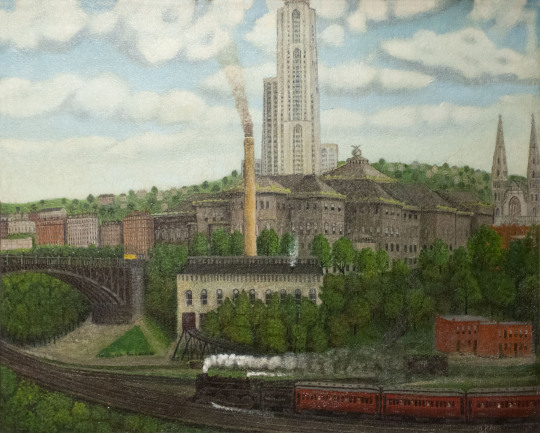
Fig. 3
Pittsburgh’s landscape painter, John Kane’s (1860 – 1934), Cathedral of Learning, circa 1930 (Fig. 3), depicts the 150-foot-deep Junction Hollow with its operating railroad. The work also includes many important architectural references, the Schenley Park Bridge (1897), Carnegie Institute’s Bellefield Boiler Plant (designed by Alden and Harlow in 1907 to supply electricity and heat to adjacent buildings), the Carnegie Institute Extension (1907), and a then unfinished Cathedral of Learning. This painting is part of CMOA Fine Arts collections.
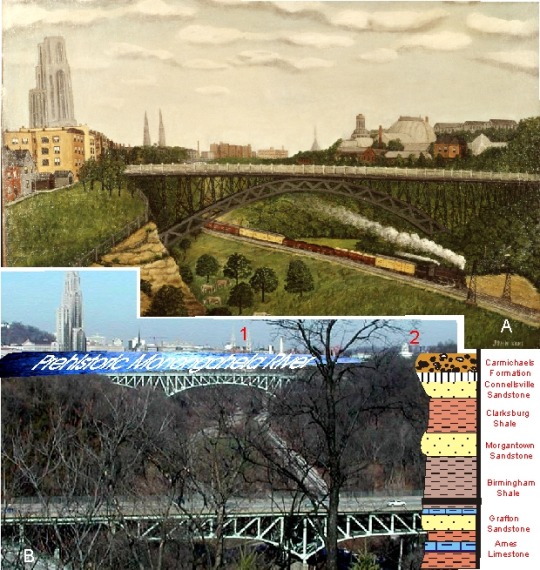
Fig. 4
Another John Kane landscape, Panther Hollow, circa 1930 – 1934, (Fig. 4A) in combination with Cathedral of Learning has been used in teaching about the 300 million-year-old geology of Schenley Park (Fig. 4B2) and the pre-Pleistocene Monongahela River that formed the flat bottom landscape of Oakland, and through erosion, Junction Hollow (Fig. 4B1). Kollar and Brezinski 2010, Geology, Landscape, and John Kane’s Landscape Paintings.
Junction Hollow Landscape:
Kane’s Cathedral of Learning (1930) is an idealized green space of Junction Hollow, the Wilmot Street Bridge in the foreground (1907) now replaced with the Charles Anderson Bridge (1940), and Carnegie Tech’s (now Carnegie Mellon University’s) Hamerschlag Hall or Machinery Hall (1912), built by Henry Hornbostel, a Pittsburgh architect. Hornbostel designed a circular Roman temple wrapped about a tall yellow brick smokestack (Fig. 4A). The design is based on the Roman temple of Vesta in Tivoli, Italy, dating to the early 1st century BC. Hornbostel’s overall campus design focused on connection between art and science, with Junction Hollow representing the geological sciences. The architect Philip Johnston, who built Pittsburgh’s postmodern PPG Place (circa 1984), once contrasted the Bellefield Boiler Plant smokestack as “the ugliest in the world to Machinery Hall’s smokestack as the most beautiful.” In novelist Michael Chabon’s debut novel, The Mysteries of Pittsburgh, (1988) the Bellefield Boiler Plant, termed “the cloud factory” by the narrator, is the setting for a pivotal scene.
Carnegie Library of Pittsburgh (Main):
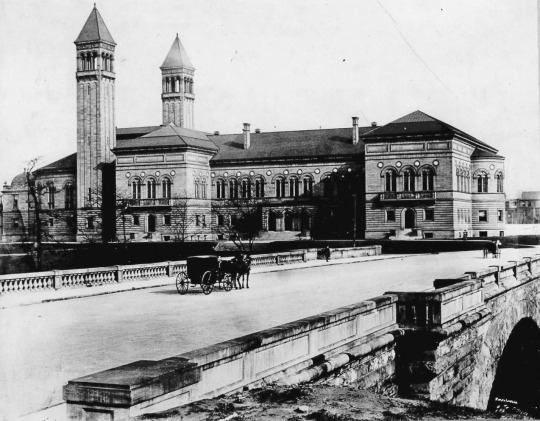
Fig. 5
The separate institutions we now know as Carnegie Museum of Natural History and Carnegie Museum of Art can track their origins to exhibits and galleries within space now fully occupied by Carnegie Library of Pittsburgh. An image of the Carnegie Library of Pittsburgh in 1902 from the Bellefield Bridge, a structure now buried under the Mary Schenley Memorial Fountain (1918), reveals eclecticism in architectural features (Fig. 5). The west facing frontage doorways and portico of the library features, CARNEGIE LIBRARY, FREE TO THE PEOPLE, and 24 carved writer names. Missing from the names is Carnegie’s favorite poet, Robert Burns, whose statue was dedicated in 1914 on the grounds of Phipps Conservancy. Three separate entrances are served by granite steps of Permian age from Vermont, one for the science museum, one for the Department of Fine Arts, and the third, with distinctive Romanesque round doorways, brass doors with intricate features, and keystone scrolling, for the Library. This entrance was designed by Harlow, who was the draftsman on the McKim, Mead, and White team responsible for the Beaux-Arts Boston Public Library (1895). When the Carnegie Institute Extension was constructed in 1907, the science museum and fine arts museum collections were moved into the new space. The former spaces in the library became the Children’s Room, Pennsylvania Room, and Music Library.

Fig. 6

Fig. 7
A challenge at this point in the tour involves discussing features that are not visible up close. The Longfellow, Alden, and Harlow’s Italian Renaissance and Beaux-Arts H-shaped parallelogram winning design featured a copula (Fig. 6) on top of the red tile roof that was never built. Eclecticism features include a double apse, a smaller shaped semi-circular extension of the library’s wall on the southside of the building, and larger apse on the north or Forbes Avenue side of the building, with the semicircular Music Hall auditorium, designed by Longfellow. The music hall exterior was structurally changed by the 1907 construction (Fig. 7).
The exterior Berea Sandstone reveals rustication masonry techniques with the cut blocks on the exterior first floor level distinguished by ashlar pillow horizontal border stone, and smooth masonry from the second floor to the cornice below the roof line. The second floor late Gothic style windows are divided by a vertical element called a mullion that helps with rigid support of the window arch and divides the window panels. Two symmetrical Campanile towers that Carnegie called “those donkey ears” were modeled after the San Marco Bell Tower in Venice, Italy. The towers served as an architectural offset to the semicircular exterior walls of the music auditorium and were removed in 1902 for the construction of the Carnegie Institute Extension. The installation of the towers can be interpreted as a tribute to Henry Hobson Richardson’s Allegheny County Courthouse twin towers (1888).
Architects choice of light grey sandstone and red tile roof:
The library’s red tile roof incorporated multiple glass roofs over the library, fine arts galleries, and science museum (all shaded from exterior sunlight today) which typified the Beau-Arts style. Keep in mind, the library did not have electric light. Light was provided by gas lighting and natural sunlight. Longfellow, Alden, and Harlow wrote that “the choice of a red tile roof and grey Ohio (Berea) Sandstone was intentional to contrast with Pittsburgh’s grey skies and the changing seasonal colors of the foliage in Schenley Park.”
The Beaux-Arts Architecture of the Carnegie Institute Extension 1907:
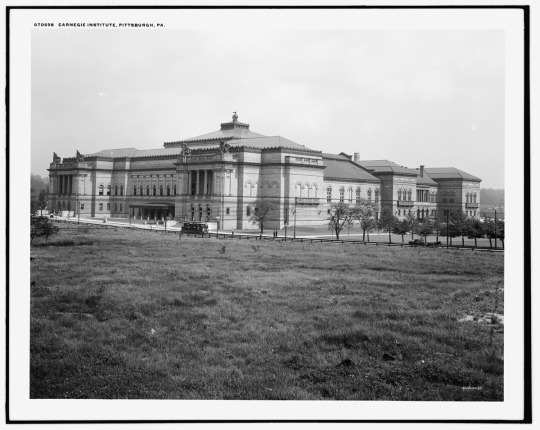
Fig. 8
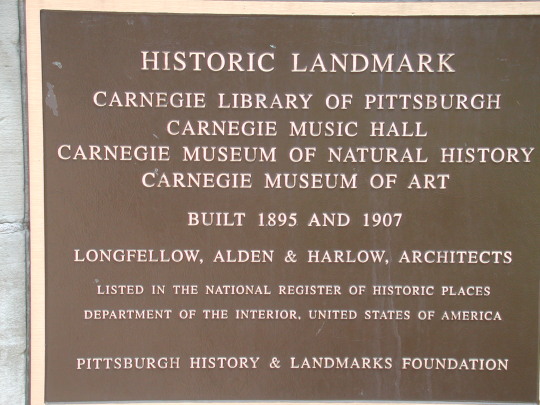
Fig. 9
After Longfellow returned to his Boston practice in 1896, Alden and Harlow received the commission to build the Carnegie Institute Extension (1907) (Fig. 8). Their efforts created one of the great Beaux-Arts building in the United States. As Cynthia Field, Smithsonian Architecture Historian, stated in 1985, “the building itself is the greatest object of the entire museum collection.” Formal recognition of the building’s architectural importance exists in two historic landmark plagues placed outside of the Carnegie Library entrance and the Museums’ Carriage Drive entrance (Fig. 9).
New exterior features of the 1907 extension work included the replacement of the red tile roof with copper, the addition of an armillary sphere, the construction, with a colonnade of solid Corinthian fluted columns of Berea Sandstone, four portico porches over the main entrances to the library, music hall, natural history and art museum, and eastside of building (now removed), and the creation, along Forbes Avenue, of a main Carriage Drive entrance with direct access to the galleries. The carved names of authors, artists, musicians, and scientists in the buildings’ entablature, a Victorian era practice, extends around the building from the library’s southeast corner to the music hall entrance, and natural history and the fine arts entrances.
Also notable along Forbes Avenue are John Massey Rhind’s noble quartet statues that guard the Music Hall and Natural History and Art entrances. The four male figures all seated in classic Greek chairs are Michelangelo (art), Shakespeare (literature), Bach (music), and Galileo (science). Standing three stories above the quartet on the edge of the roof, four groups of female allegorical figures represent literature, music, art, and science as well. The bronze figures were casted in Naples, Italy in 1907 (Fig 8).
Inside the 1907 Architecture and Building Stones:
The architects created 13 new interior spaces where three grand spaces stand out for specific architecture styles such as, the Beaux-Arts Grand Staircase (voted in 2018 as the 8th best museum staircase in the world), the Neoclassical Hall of Sculpture, and neo-Baroque Music Hall Foyer. The extension used 32 varieties of marbles and fossil limestones, many from antiquity, quarried and imported from Algeria, Croatia, France, Greece, Ireland, Italy, and the United States.
Since 2004, the collaboration between the CMP Travel Program and the Section of Invertebrate Paleontology has been highly successful reaching out to our members and patrons. This summer’s tours generated some particularly appreciative comments:
The Carnegie's resident scientists are a defining characteristic of this noble institution. Might be an anachronism in an era when museums are focused on providing 'destination' entertainment and hosting special events for swells, but while treasures like Dr. Kollar are still on staff, it’s a splendid idea to facilitate interaction between them and museum visitors. Congratulations on a most enjoyable program. -Ron Sommer
Albert was very informative and interesting. I found it most valuable learning the history of the area. -Janet Seifert
I can't stress enough how unusual and interesting it was to have a geologist give us the tour. It had never occurred to me before that there's so much one can learn about building materials from a geologist. -Neepa Majumdar
Albert D. Kollar is Collection Manager and Carnegie’s Historian of the Carnegie’s Building Stones. Barbara Tucker is Director of Carnegie Travel Program.
14 notes
·
View notes
Text
Special 300 followers post: places to visit while in Romania (5/5)
Part 4
33. Praid Salt Mine
Salina Praid or the Praid Salt Mine is a large salt mine located in central Romania.
Praid represents one of the largest salt reserves in Romania having estimated reserves of 50 billion tonnes of NaCl. People visit the salt mine either for therapy or tourism. Speleotherapy and climatotherapy are based on the inhaling of the mine air, which could be beneficial for respiratory problems. Besides the health benefits, the beauty of the mine attracts tourists all over Europe. Equipped with hundreds of wooden tables and couches, a buffet, many playgrounds for children, a small wooden church, pool tables and even an internet-cafe, the underground chambers see up to 3 thousand visitors per day at the peak of the season.




34. Turda Salt Mine
Salina Turda or the Turda Salt Mine is a salt mine in northwest Romania.
Opened for tourists in 1992, the Turda Salt Mine was visited by about 618,000 Romanian and foreign tourists in 2017. The Turda Salt Mine was ranked in 2013 by Business Insider as among the "25 hidden gems around the world that are worth the trek". One of the main attractions is the Crivac Room; the octagonal room hosts a winch called "crivac" or "gepel", rudimentary machinery used to lift salt rocks on the surface. It dates from 1881. This machine replaced another, smaller in size, that was installed in 1864. It is the only machine of this kind in all salt mines in Romania and probably in Europe that keeps in its original location.




35. Sarmizegetusa Regia
Sarmizegetusa Regia was the capital and the most important military, religious and political centre of the Dacians prior to the wars with the Roman Empire.
Towards the end of his reign, Burebista, the founder of the Dacian Kingdom, transferred the Geto-Dacian capital from Argedava to Sarmizegetusa. Serving as the Dacian capital for at least one and a half centuries, Sarmizegethusa reached its zenith under King Decebal. Archeological findings suggest that the Dacian god Zalmoxis and his chief priest had an important role in Dacian society at this time. They have also shed new light on the political, economic and scientific development of the Dacians and their successful assimilation of technical and scientific knowledge from the Greek and Romans. Sarmisegetusa's walls were partly dismantled at the end of First Dacian war in AD 102, when Dacia was invaded by the Emperor Trajan of the Roman Empire. The Dacians rebuilt them, but the Romans systematically destroyed them again in 106 and deported the inhabitants. With that said, if you visit this site, please be respectful, don't litter and do not bother archaeologists if you see them, because the ruins already dealt with some damage from a parking lot being built there without any authorization from archaeologists, endangering the ancient walls. Also, keep in mind that with the resurgence of Pagan beliefs across Europe, this site may be as sacred to Pagans who believe in Zalmoxis as would be Greek temples to Hellenistic Pagans.

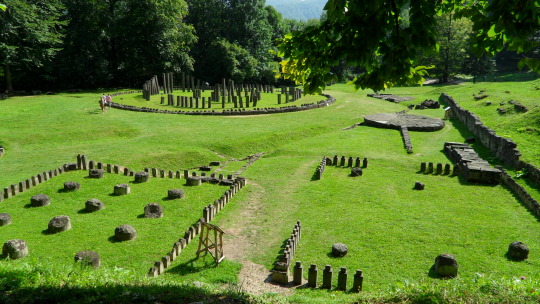
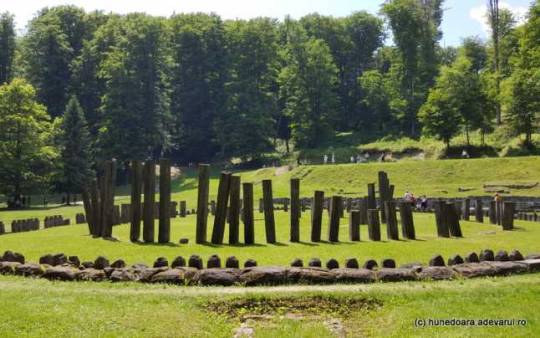

36. Sighișoara
Sighișoara is a city located in the historic region of Transylvania, Romania.
It is a popular tourist destination for its well-preserved walled old town, which is listed by UNESCO as a World Heritage Site. Sighișoara is considered to be the most beautiful and well-preserved inhabited citadel in Europe, with authentic medieval architecture. In Eastern Europe, Sighișoara is one of the few fortified towns that are still inhabited. The town is made up of two parts. The medieval stronghold was built on top of a hill and is known as the "Citadel". The lower town lies in the valley of Târnava Mare river. The houses inside Sighișoara Citadel show the main features of a craftsmen's town. However, there are some houses that belonged to the former patriciate, like the Venetian House and the House with Antlers. In 2001-2003 the construction of a Dracula theme park in the 'Breite' nature preserve near Sighișoara was considered but ultimately rejected, owing to the strong opposition of local civil society groups and national and international media as well as politically influential persons, as the theme park would have detracted from the medieval style of the city and would have destroyed the nature preserve.

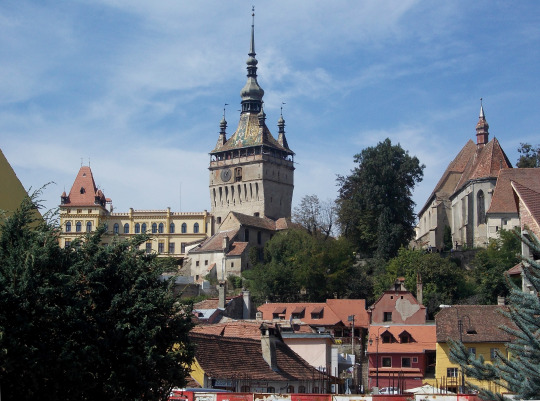
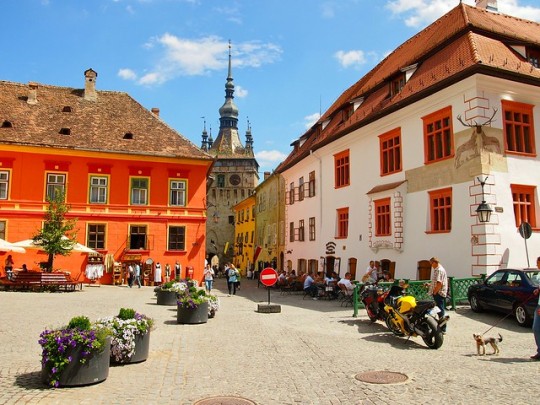
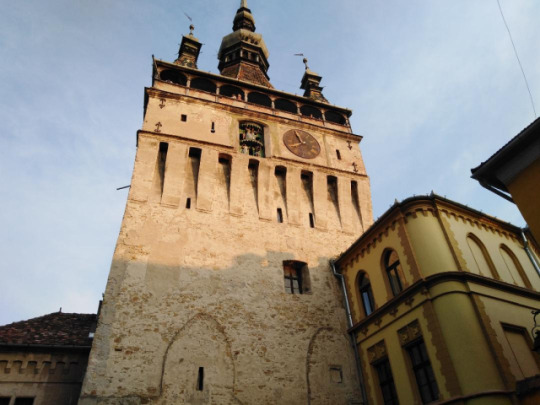
37. Târgoviște
Târgoviște is one of the most important cities in the history of Wallachia, it was its capital between the early 15th century and the 16th century.
Throughout the period it was the capital of Wallachia, the Princely Court in Târgoviște (Curtea Domnească din Târgoviște) had been constantly refurbished and extended. The compound was surrounded by stone walls and a moat and a new church and a tower had been built. Vlad III Dracula ("the Impaler") later added the Chindia Tower, now a symbol of the city. Starting with 1465, for the next two centuries, the rulers alternated the capital between Târgoviște and Bucharest, often on political reasons, as the former was preferred by the rulers who were more friendly toward Transylvania and the King of Hungary. Throughout the 15th and 16th centuries, Târgoviște was a major trade hub, especially with Poland, Brașov and Sibiu. Târgoviște was the site of the trial and execution of Nicolae Ceaușescu and his wife Elena on 25 December 1989 during the Romanian Revolution.



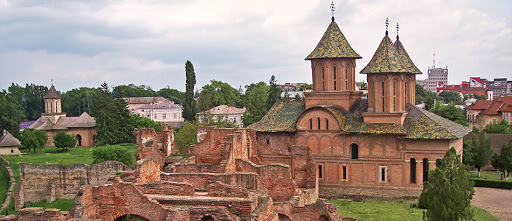
38. Transalpina
Transalpina or DN67C is a road located in the Parâng Mountains group, in the Southern Carpathians of Romania, is one of the highest roads of the Carpathian Mountains, connecting Novaci, south of Parâng Mountains, to Sebeş in the north.
The road was built under King Carol II over an old Roman road and consolidated during World War II by German troops. The road has its highest point at the Urdele Pass, where the elevation is 2,145m above sea level. Given the high altitude, the road is closed during the cold months of the year. Works began in 2007 in order to transform this spectacular road into a modern highway (148 km), allowing a rapid transit between Oltenia and Transylvania. Rânca, a newly developed resort, is located towards the south end of the Transalpina road.


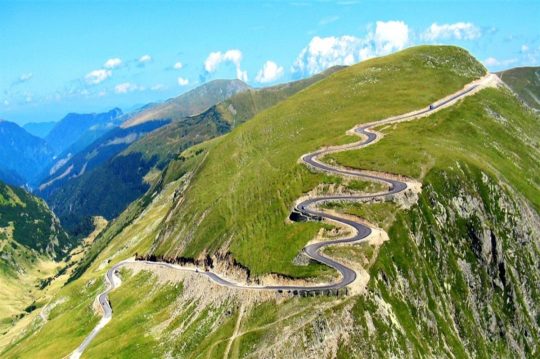

39. Transfăgărășan
Transfăgărășan or DN7C is a paved mountain road crossing the southern section of the Carpathian Mountains of Romania.
It starts near the village of Bascov, near Pitești, and stretches 90 kilometres (56 mi) to the crossroad between DN1 and Sibiu, between the highest peaks in the country, Moldoveanu and Negoiu. The road, built in the early 1970s as a strategic military route, connects the historic regions of Transylvania and Wallachia. The road climbs to an altitude of 2,042 metres (6,699 ft), making it the second highest mountain pass in Romania after the Transalpina. It is a winding road, dotted with steep hairpin turns, long S-curves, and sharp descents. It is both an attraction and a challenge for hikers, cyclists, drivers and motorcycle enthusiasts. Due to the topography, the average speed is around 40 km/h (25 mph). The road also provides access to Bâlea Lake and Bâlea Waterfall. Transfăgărășan was featured in a segment of the British TV show Top Gear, in the first episode of Series 14 (November 2009). Host Jeremy Clarkson proclaimed that the Transfăgărășan was "the best road in the world," a title the presenters had previously given to the Stelvio Pass in Italy.


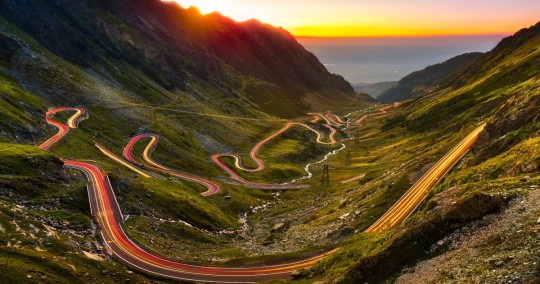

40. Ulpia Traiana Sarmizegetusa
Ulpia Traiana Sarmizegetusa was the capital and the largest city of Roman Dacia, named after the former Dacian capital, located some 40 km away.
Built on the ground of a camp of the Fifth Macedonian Legion, the city was settled by veterans of the Dacian wars. From the very beginning it received the title of colonia and the status of ius Italicum. With an area of 30 hectares (74 acres), a population between 20,000 and 25,000, and strong fortifications, Ulpia Traiana was the political, administrative and religious centre of Roman Dacia in the 2nd and 3rd centuries. The city was destroyed by the Goths. Today Ulpia Traiana remains in ruins, with a partly preserved forum, an amphitheatre, and remnants of several temples.




And with that, this special series of posts is complete. I am sorry for taking this long to post this, but I had to think hard what to include and not to include, and, of course, to gather all the information and photos. I hope you liked it, and don’t forget, Romania has much more to offer and show than what I showed here. If you ever visit, I hope you’ll like it here and have fun! Otherwise, see you Sunday for a regular post!
#România#Romania#Transilvania#Transylvania#Muntenia#Oltenia#Țara Românească#Wallachia#Dacia#Roman Dacia#Salina Praid#Praid Salt Mine#Salina Turda#Turda Salt Mine#Sarmizegetusa Regia#Sarmisegetusa#Sighișoara#Târgoviște#Transalpina#DN67C#Transfăgărășan#DN7C#Ulpia Traiana Sarmizegetusa#Ulpia Traiana
81 notes
·
View notes
Text
greek mythology aesthetics
aes: persephone
dark mornings when nobody else is awake, biting his lip till he bleeds, flower-shaped bruises and bullet-shaped hickeys. lust, sharp, black winged eyeliner framing bright, angry eyes where the stark blue shades seem to twist and tumble around in the light, perfectly applied crimson lipstick and cheekbones that could slice your skin open. wedding dresses covered in bloodstains and dirt, crumpled old polaroids of tanned teens decked in flower crowns, furious, screaming arguments that split open the floor, earthquakes and finding the best in natural disaster, roses growing out of slit wrists and tragedy.
aes: hades
brooding in the dark for days on end, sudden bursts of fury where you throw things on the floor and smash them, misunderstood teens, wanting to be liked and sarcasm. swelling orchestral, dramatic rock music, black bedclothes tinged with deep purple and green and blue, cracked windows and alcohol-induced shaking hands, crows that circle your roof and black eyes glinting with silver slits. snakes and finding comfort in the dark, burnt wings and tousled dirty hair, old books with well-thumbed pages, lust and aggressive kissing. stroking her soft hands while you sit together, sharing a charred wooden throne and subtle touches of the arm throughout the day.
aes: icarus
sitting across from the window to feel the sun's warmth filtering through the glass, bright, whiskey-coloured eyes, optimism and books about angels, dark nights spent reading the same books over and over and flickering candles. tiny wooden carved figures, circular gold-rimmed hipster glasses, freckles on light brown skin and not trusting people’s advice. getting grounded and stuck inside all day, the smell of burning skin, old poems copied onto your hands in scribbled biro, obsessions with fire and charcoal drawings of the weather almost every day. fingernails gummed up with wax from making candles and origami wings made of construction paper, engineering equations in flaky chalk on a blackboard and hot summer days when the whole room glows yellow.
aes: achilles and patroclus
subtly nudging his arm when something reminds you of an inside joke, nursing each other back to health after battle injuries, smoothly carved gold-tipped arrows and perfectly structured bows, tracing shapes on his skin and hiding together in the dark. kaleidoscopic, mosaic-like eyes, colours merging and moving together, bronze coins, flakes of white from the temple brickwork caught on your clothes, “name one hero who was happy...i can’t...i aim to be the first”, and noticing the rust-like dried blood and raised scars littering his shoulders as you hold him. limping, learning morse code, sarcastic affection, laughing whilst struggling out of armour, fine glitter under your eyes and untangling thin golden wreaths from his hair.
aes: orpheus and eurydice
contrasts in personality, shy versus outgoing, evenings spent listening to old records, graph paper covered in scribbled lyrics and notes littered over the floor, perfect white weddings, light sunset-coloured glitter dusting her cheekbones, sudden scenery changes and habitually never looking where you’re going. groups of people you know you can’t trust, intense jealousy, racing and weaving in between trees, snake bites and tiny pinprick cuts that hurt more than you’d expect, personal ballads and laments that make even strangers cry and dark tunnels. soft pastel-themed bouquets stained with dirt, the crunching noise of someone falling to the floor, “don’t go into the light”, not controlling your impulses, cruelly specific rules getting you in trouble, dappled sunlight hitting pale skin and shadows wrapping themselves around you.
aes: helen of troy
mirrors and men everywhere, confidence in your reflection, fresh bedsheets the morning after, cliche running away with giggles and held hands, soft pink lips puckered into a pout, jealousy and betrayal. never truly being on anyone’s side, always winning, love notes scrawled in expensive ink on thick folded parchment, passed discreetly between hands, flimsy, gold, low-cut dresses, holding your finger to your lips to signal silence, not keeping secrets, gossip, knowing looks and always somehow being trusted. being caught swearing as a teen, free and obnoxious laughter, questioning your own morality, blowing things out of proportion and inadvertently causing fights between other people.
aes: medusa
teenage years, acting defensive, thick, wiry dyed hair, dark green dirt school blazers, silver snake rings wrapped around your fingers and staring at nothing. always having cold hands, pale mottled skin, dirty white shirts, being blatantly lied to, frozen puddles in the winter and warped grey, stone statues. cracks in the pavement, irrational fear, being forced into the role of the outcast, jealousy and doling out punishment. hateful glares, dark bruises blooming in green, black and purple, punching the wall and cracking the plaster, lisping the letter s, creepy gothic music with slow, groaning bass and soft drums, mumbling to yourself in a low voice and still, grey eyes. boasting and being told you’re wrong, curses, avoiding mirrors, ironic punishment and knowing the difference between confidence and arrogance.
aes: zeus
angry storms, standing outside and basking in the rain, checking over your shoulder for threats to laugh at, asserting your authority, splitting your knuckles punching the wall, cracking windows in fury and shards of glass littering the floor. taking joy in ironic punishments, gold rivers and dark blue robes, glinting silver, warzones and strong drinks, army officers jacket covered in medals and stained in other people’s blood, bright neon signs and sailing trips where you fight against the sea not to be capsized. vengeance and perfect aim throwing tridents, fluency in foreign languages, control and fatherhood. aggressive love-making, angry wives, towering mountains capped with snow, cigarette smoke surrounding your head and thick, long grey hair.
aes: medea
vengeance, bloody knuckles, running away, planning and plotting, love at first sight, being usually nice but ruthless after betrayal, guilt and hiding. cliche eyes that glint mischievously when the sunlight hits them, soft lips being aggressively kissed, riches to rags instead of rags to riches, deep royal blue, purple and red dresses dirtied and burned, that internal punch in the gut you feel when you get replaced and “teaching someone a lesson”. prophecies and steaming potions, knowing the exact ingredients of a recipe by heart, hip flasks filled with strong drinks hidden under the layers of your dresses and causing quick diversions. soft, dark hair with natural highlights in loose ringlets, hoop earrings and dusty pink eyeshadow, gentle, natural-looking lipstick and sharp, murderous warning glares when someone dares to wrong you.
aes: pandora
never doing what you’re told, “curiosity killed the cat”, boxes filled with coloured smoke, causing problems but having small solutions and never giving up hope. colossal mistakes, innocence, perfection, looking ethereal and pure, roses in vases filled with alcohol, blue glitter adorning the parting in your hair, butterflies, gifts and growing purple flowers in the cracks of the pavement. dainty fingernails painted baby pink, s,weet fruit going out of date too fast, angry angels, guilt, a string of green fairy lights going out and only managing to fix one bulb, jars of honey surrounded by bugs, screaming “I’m sorry” and perfect droplets of dark blood staining pale, smooth skin. marble statues smashing and uselessly trying to stick the pieces back together, shiny blades, soft hair that’s so blonde it’s almost white and naïvety.
#aesthetic#aesthetics#greek#greek mythology#mythology#myths#writing#pandora#medea#zeus#medusa#helen of troy#orpheus#euridyce#orpheus and eurydice#achilles#patroclus#achilles and patroclus#icaurs#hades#persephone
254 notes
·
View notes
Note
Do you listen to music when writing?
Well, that’s a bit of an interesting story.
Prior to writing Steven Universe stories, I absolutely could not listen to music of any kind while writing. Even if was just lowkey instrumental/ambiance, for some reason it ALWAYS triggered my mind to imagine other stuff, which made writing all but impossible for me as long as there was noise around.
So for 85-90% of my writing career, that answer would be a hard no.
When I started working on Gem Ascension, suddenly that changed. I still can’t listen to music where there’s actual singing involved (unless it’s just really subdued or aesthetic choir noises), but I found myself better able to write whenever I had some scene-appropriate BGM playing. Usually from video games.
There’s a few wonderful souls on Youtube whose entire channels involve posting BGM tracks of all sorts of different series (seen it with games, anime, and wrestling tunes at least) - in 30-minute loops.
This is immensely helpful for me, as I write huge amounts of content and thus tend to be stuck in a scene for a good while. And my momentum would be broken up big time if the track ran out at its original time and shifted to something that completely throws the mood off. Having the tracks extended to 30 minutes makes that much of a difference to me.
I’m really not sure why now I’m able to listen to at least some form of music while writing when I spent nearly 2 decades not being able to do it at all. But there you go.
I’ve gone through MANY tracks from many different games, anime, and wrestling themes throughout my tenure of writing my Gem Ascension continuity, but I’ll say my go-tos are largely due in part to the tracks of Chrono Trigger and Chrono Cross (by Yasunori Mitsuda).
Best of that pack for writing: Corridors of Time, Mystery of the Forest, Undersea Palace, Silent Light, Chronopolis (my default Homeworld scene music), Star-Stealing Girl, Death Volcano, and Edge of Death.
David Wise’s music was also just as much-used and essential to my progress. Choice tracks include:
Fear Factory, Aquatic Ambiance, Life in the Mines, Northern Hemispheres, Treetop Rock, Crocodile Cacophony, Forest Interlude, Flight of the Zinger, Mining Melancholy, Hot-Head Bop, Hot-Top Volcano, Jungle Falls, Darkmoon Caverns,
Koji Kondo gets an honorable mention, because Dire, Dire Docks was a VERY often-used one for me. As did Koopa’s Road, Mario Kart 64′s version of Rainbow Road, Inside the Deku Tree, Forest Temple, Spirit Temple, Water Temple, Last End, Ikana Valley, and Stone Tower Temple (+ Inverted Version).
Super Mario Galaxy has an OST made for epic Steven Universe fics where off-world stuff is the focus. Buoy Base Galaxy, Space Junk Galaxy, Pipe Interior, and Ghostly Galaxy just to name a few.
And of course, I often used some choice Nobuo Uematsu classics from Final Fantasy. And also the Final Fantasy games after he stopped composing for them. Anxious Heart, FF7′s Main Theme, On That Day 5 Years Ago, Life Stream, Chasing the Black-Caped Man, Who Am I, Shinra Army Wages a Full-Scale Attack, If You Open Your Heart, The Birth of God…
Stevidot scenes often had me using Tifa’s Theme and Serah’s Theme - Memory (the latter very shamefully).
I remember spamming New Bodhum for the scenes at the Crystal Temple/Steven’s house. Surprisingly the singing didn’t throw me off here.
Same can be said for Historia Crux and Plains of Eternity.
And yes, I have used tracks from Final Fantasies IV, V, VI, VIII, IX, X, and so on. But I’d be here all day listing those.
Hilariously, I recall special songs I had playing in 30-minute chunks as I neared the end of GA Act III: Super Mario World’s Ending Theme, Super Mario 64′s Staff Roll, Chrono Trigger’s To Far Away Times, Sonic the Hedgehog 3′s Credits, Sonic CD’s Sonic Boom (Ending Version) (one of the few exceptions where songs with singing didn’t throw me off)…
But the very last track that played as I finished the original Gem Ascension trilogy?
To the Moon - from Ducktales Remastered. Though honestly, I was cycling between that, the original version, and this amazing orchestral fan remix.
…. I didn’t expect that answer to be nearly as complex as it became. Uh, enjoy the music selection that inspired GA, I guess? :P
#answered asks#potionmaster37#writing#music while writing#yasunori mitsuda#david wise#koji kondo#nobuo uematsu#god knows how many others#final fantasy vii#final fantasy xiii-2#chrono trigger#chrono cross#donkey kong country#donkey kong country 2#diddy kong racing#super mario 64#super mario galaxy#super mario world#sonic the hedgehog 3#sonic cd#ducktales#ducktales remastered
15 notes
·
View notes
Text
“Withering Albatross”
Amon x MC
SFW Horror Genre
Notes: This is NOT fluff nor smut.
TW: brief mention of needles
Halloween Themed- Prompt List WC: 1,556
74“You don’t feel it yet, but you will soon.”
Ikemen Revolution Fanfic
Water splashed over the side of the tub as I plopped down into the bubbly concoction, unconcerned for the slippery consequences ahead. I sank down under the tower of bubbles, keeping my nose just above the waterline. I made sure my shoulders where being soaked in the heat since that’s where I was holding my tension.
The guys had been nice to me since I arrived at their headquarters. Yet, I still felt a sense of uneasiness as the evening went on. Once the time came for me to sleep, the silence of being alone caused the pit in my stomach to grow.
I rubbed my arm under the shield of bubbles, coaxing my muscles to finally relax, to no avail. Flipping abruptly to my right, the water sloshed around me in waves. I allowed the right side of my hair to dip down further, watching it swirl around in the liquid ether.
Going out of their way for someone they just met, throwing a party and preparing a room for my stay, gave me a sense of easiness. Despite my worries a small hope sprang up inside of me. They seem to take me on as their own so quickly, calming me marginally. Maybe I actually could make it here for a month.
Outside the comfort of the warm bath, I darted across the cool bedroom in freshly laundered sleepwear, to my new bed for the next moon cycle. Slipping under the covers in the dark, I pulled them up to my chin. I followed the patterns on the ceiling now that my eyes had adjusted to the dark. However, my rapidly cooling body temperature seemed rip through the veil of comfort I painted for myself.
My chest was heavy as a suffocating weight bore down onto me, keeping me from moving. My mind misfired over and over as I tried to process all the new information I gained. Even with their comforting words and promises, I was in no shape to relax with the information I was ‘safe’.
Sleep evaded me for hours, I worried for the life I was ripped from when I fell into that damn rabbit hole. What would happen to my home, and my job? Would anyone even be looking for me if I was missing for that long?
Tiny insecurities became huge rips in my psyche the longer I lay in the foreign bed. The soft sheets felt like a trap, coaxing me into a sleep that I wasn’t sure I could benefit from. My head felt like a rock, growing heavier the more the clock on the wall ticked away.
After many long hours of staring up at the alien ceiling, sleep yanked me down into its bothersome embrace. My mind dipped into the inky ocean of dreams, yet my body kept a keen sense of my surroundings in the present room.
Visions of flipping and twisting nauseated me. The walls of the small cylinder I fell through, wiped past me at neck breaking speeds. Another long sigh fell off my lips as the walls twisted and turned, aggravating me. The tunnel stretched on for days while I continuously plummeted. As soon as the sinking feeling in the pit of my stomach grew accustomed to the falling sensation, it would start back up in my throat again bringing an unbridled panic to the forefront of my mind once more.
I tried to find the comfort in the discomfort to no avail. I crossed my arms only spinning faster, then tired pulling my knees to my chest, yet every position was just as repugnant as the next. My vision flickers when an icy sensation crept over my head. I clenched my eyes, but through the dream I became painfully aware of a sickening sting wash over the back of my neck.
I woke up with a start, bolting upright in bed just to be held down by solid hands. My eyes craned around the room in hopes to make sense of my interrupted sleep. As my pupils dilated, two figures boring over me came into view. One man held my torso down with one large hand while the other continued to prod my neck.
“AH!” I yelled, thrashing my legs wildly into the nondescript figure.
His other hand flew up to my mouth, pushing hard enough for my teeth to cut the inside of my lip. The icy feeling on my neck began to centralize into a sharp pain I could pinpoint.
“Is that all of it, Amon?” the shadowed figure over me spoke in a hushed tone.
I jerked my body again in defiance.
“Pretty much.” The other cloaked man spoke in a huskier voice.
“HM!?” I voiced under the solid hand.
“You don’t feel it yet, but you will soon.” Amon pulled away from my neck, bringing a small syringe into view.
The icy pain began to spread down my back, racing through my veins towards my extremities. What was this he injected me with? Who were these two men and how did they get in here?
My thoughts slowed as a darkness deeper than sleep encased me, numbing my body before finally my taking away my sight.
My eyes tried to part, yet they were sticking together as if I had been asleep for days. I managed to wiggle my fingers rousing my body from its forced coma. My back hummed with numbness from the lack of circulation.
Weakly, I brought my hand up to my face, rubbing the sleep from my eyes. Then, running my fingers over my chapped lips, I felt the razor sharp ridges prod the tip. I moved my tongue to lap at them, realizing it felt as if I had swallowed cotton. My dry throat began to flex at just the mere thought of water.
I moved my neck to the side, feeling it pop when I managed to do so. Another unfamiliar room came into focus. I noted the damp stone walls, rusted iron bars and a hay covered floor. I was in the far corner, laying on the solid floor shrouded in a dark shadow thanks to the lack of windows in the frigid cell.
What did I do wrong to be brought here? Panic surged through me, yet my muscles were too weak to react. My arm plopped back down to my side as a rushing headache began pulsing in my skull. My temples throbbed but I did nothing to try to soothe myself. I was here, by shear bad luck but somehow it felt like I deserved it.
I sat unmoving for hours, leaving me with only toxic thoughts. I wanted to pinch myself, to snap myself out of it and say ‘Hey, the black army promised to protect you. They may be coming for you right now’
I tried to scoff at my own words, yet my mouth stuck together miserably. I knew I should be hungry, yet it seemed as if my body was too weak to even register that basic need.
I don’t know how much time passed or when I fell asleep again, but a loud crash roused me from my dreamless state. My heart fluttered like a hummingbird desperately trying to keep up with my minuscule movements.
“HELLO!?” a deep voice shouted into the cell block.
My eyes shot open feeling that small spark of hope again ignite within me. I tried to clear my throat to speak. I’m sure it would sound like a croak, but any noise I could make would help them find me.
I parted my lips, cracking them further. “...” Panic rushed over me when no sound came out.
My throat was too parched and my body was too weak.
“I check the other blocks, they were empty.” another voice echoed off the walls.
I sucked in a shallow breath. “...h..”
‘FUCK!’ I yelled in my head ‘IM IN HERE’ I began screaming in my own mind.
My dry eyes stung as I stared through the bars, watching the tall figure walk by. They glance into my cell, but didn’t spot me laying in the dark corner. I visualized myself jumping to my feet and rushing over to him as I banged on the bars, but my body wouldn’t respond to my attempts.
So feeble and powerless, my legs trembled at the thought of holding my weight.
‘No! Please don’t leave me here!’ I screamed in my head over and over.
Tears never fell from my eyes, yet in my state of dehydration I wasn’t surprised. The figure passed my cell and turned back the way they came. I couldn’t even ball up my fist in frustration.
I tried calling out again. “....” and again “....”
My chest heaved as a sob broke over me, my mind was shattering as I screamed to myself.
“This one’s empty too.” The deep voice reported to the other.
‘No! It’s not empty!’ I clamored for my voice for any noise, even a squeak.
The heavy sound of the metal slamming shut jolted my body once more. I stared at the bars in disbelief. They had come for me, but it was too late.
They were too late.
.
.
.
I’ve never written anything like this... but I wanted to do something dark and spooky for Halloween. SO! with that being said, I hope you enjoyed.
#ikemen revolution#ikemen revolution fan fic#tw needles#amon jabberwock#sfw#lastteaparty#alloveroliver
53 notes
·
View notes
Video
youtube
Really great analysis of Zelda Breath of the Wild. I love his thoughts on exploration and environmental storytelling.
Reduced focus on narrative due to simplistic story
Maximize freedom - early Ganon kills needs to be possible
Not capitalizing enough on the backstory other than the main quest
At first the Forgotten temple seems like just the kind we’re looking for, but once you come over the shrine the place feels tainted a little. Instead there could have been some kind of mural on the back wall which visually explained another version of the backstory.
Zelda could have chimed in more often every time we found a relic of Hyrule’s history. Voice acting without interrupting the gameplay.
The map itself was just a generic terrain overview
Place names appeared only after they’ve been visited
Prevents lazy players and developers from relying on it too much
Destructive trend: entering an area causes its place name to appear in bottom left corner.
If the temple of time didn’t say “Temple of Time” down here, how would you know it was the temple of time? First it was the piano theme. Link could only discover this was the temple of time by opening the Sheika slate map. There’s nothing visual cues, items in it or anything around that even suggests it was somehow related to time. In other words, it’s actually not a temple of time. It’s just a generic cathedral with a name attached.
Ocarina of time had the same issue
Tons of details scattered around the world, big and small
You can tell these Bokoblins have been practicing their archery
Arrows in the entrance gate of Kakariko village hint at either a bored villager or something even more sinister
These guys are delighted to have found some durians
Riju’s seal plushies wordlessly hint at her immaturity
Robbie’s lab used to be a lighthouse
The three hinox holding the keys to this shrine couldn’t have possibly been alive when the Sheikah erected the hint tablet, but they also happen to live inside massive rib cages which were the actual giants referred to in the text.
Many NPCs have quirks and moments to be discovered
Koko struggling to stay awake so she can protect her sister
But Hyrule suffers from the sense that there’s not much definitive history to be found
Next to Hateno village, there’s a dilapitated horseback archery course. A nearby house holds some arrows, which presumably would have been sold to customers. Even it’s location on the main road makes sense for a business. All these things paint a picture of better time when the owner would solicit passing travelers. Riding a horse through it while picking off a few neglected targets sells the post-apocalyptic setting because it tells a story and even allows the player to become a part of it in their own way.
Not many ruins like this to come across though
Most relics of the past just seemed like generic stone structures or burnt out houses. Makes sense that not EVERY place should be meaningful. But some places that should be aren’t.
Lake Hylia’s bridge is bookended by two towers complete with arrow slits and battlements, but there’s no way for guards to enter them. There’s no doors, no interior, and thus no sense that this was ever actually in use.
Lanayru Promenade, the Coliseum, and Akala Citadel give off the same hollow impression
Guardian husks are well utilized in a couple of places, most notably Fort Hateno. But they crop up a bit too often for their own good, robbing them of some of their importance.
This might be an underlying problem in how all of these ruins ultimately stem from a single event, leaving you with little to learn from their downfall.
Considering the focus on exploration, archaeology seems like a fitting inclusion.
So some decorative artifacts could have still been lying around in a few places waiting to be sold off or be displayed in Link’s home.
Nintendo is family friendly, so there’s a lack of human corpses in the overworld, although they could be used to great effect in storytelling.
Flashbacks, voiceovers, murals, architecture, corpses, spirits, artifacts ... All these avenues for fleshing out the world remain largely underutilized. Probably because of the extra resouces it would take, but maybe also because the area text engendered some complacency about how severe this problem was.
If discovery is a reward for exploration, then another detrimental trend is the reuse of Hyrule.
You don’t need to be a Zelda expert to identify Death Mountain and figure out that’s probably where the Gorons are. Try to remember back to that first Ocarina of Time playthrough. Gorons were a new addition in that edition and entering Goron’s domain resulted in a bunch of discoveries about them: they can roll around, they eat rocks, they have a chieftain, they’re having troubles, and they have a unique culture to be experienced.
These renditions of familiar faces are superb in their execution though.
Zora’s domain looks beautiful
Korok forest looks more lush than ever
The Rito bird nest is an inspired design
Fantasy races are often homogenized, but here each race has tons of variations within themselves.
Completionism and sense of permanence
If not for the blood moon, clearing out enemy camps might have been: the satisfaction of taking back Hyrule. Presumably this isn’t possible for technical constrains and ensuring the world remains filled with combat encounters and resources no matter how long the players take to explore. If they felt that their actions had an impact on Hyrule, it might be enough to motivate them instead of more combat engagement, not less.
Tarry town quest is weak. Essentially it involves talking to NPCs until you find the right one, gather rewards, then repeat times five. At least nice to have gathering wood to be the focus for once -- more purpose to the mechanic. Relaxing to be working towards building a town and the mundane way than usual for a Zelda title. But repeat too many times, it can feel like a slug.
900 koroks to find -- to make sure an average players will stumble across a reasonable amount
Standout areas to appreciate even if they lack permanence or distinct rewards.
Thai flow forests reduced visibility
Lost woods: entry puzzle, three well-rounded distinct side quests, a cave of ordeals, most lively rendition of a forest town yet
Yiga clan hideout has enforced stealth plus unique boss
Eventide island
All these places have something in common: they’re restrictive
Just look at the path to Zora’s domain:
more restrictive gameplay can lead to more memorable outcomes
It rains here and its a mountainous region. So the most reasonable option for progresss is to follow the path, which makes the player run into several enemy encounters. Given the choice you might be the player who fights them just because, but if you’re the type to go around, placing them right here in your path makes them more of a threat, which encourages you to take them out.
Nerf the paraglider a bit
Won’t work if Link can continue to effortlessly glide over so much terrain
Should function more like Skyward Sword where it was simply used to break falls. Would make a fast way to descend without being so easily abusable.
Shield surfing would then be a more feasible way to cover distance by speeding down sllopes.
Actually more satisfying to cut down trees to cross ravines
Their camouflage is too easy to notice.
So such ambush tactics is just what this kind of open world needs.
Others have similar tricks: Octorocks, Koblins, minor talus, Yiga clan members.
At worst they feel like random encounters
Problem: easy to run away after they reveal themselves
Lionels and mounted bokoblins are the only real cases where fleeing might result in death
Deku scrubs, Bodongos, and the likes are missing - but also present due to octorok vairants accomplishing much the same thing
(... TBC 32:33)
Something addictive about trying to grab that perfect shot of wildlife (photographer)
BOTW doesn’t have enough variation given its size
Eventide island: people value every equipment and food they can obtain
Players can make it harder for themselves by sticking to self-proposed rules
making an experience feel real (reality) vs making it simply look real (realism)
Pro mode simply hides the menu items ➡ more immerssive
4 notes
·
View notes
Text
Reviews 201: Il Guardiano del Faro
Several weeks ago I covered Choice Works 1982 - 1985, Time Capsule’s loving, informative, and visually gorgeous Yuji Toriyama retrospective. But Yuji wasn’t the first balearic hero of years past to get this special treatment, as Time Capsule had a few months prior released a deluxe reissue of Il Guardiano del Faro’s Oasis. This cinematic epic was crafted by Federico Monti Arduini and a few friends in 1978 from his seaside paradise of Porto Santo Stefano, and sees Poly and Mini-moogs, string synths, e-pianos, drum machines, echo boxes, and tape recorders uniting for a radiant waltz through mirage-shrouded desert dreamworlds. There are ambient disco burners, swooning Italian film orchestrations, proto-new age and post-classical expanses, exotic jazz fusion adventures, and moody Morricone/Alessandroni-style spaghetti western guitar meditations, all working together to achieve Federico’s goal of helping the listener understand that “inside, they are vulnerable and emotional but stubbornly alive.” Of course, the liner notes are detailed and captivating, tracing Federico’s development from a child piano prodigy through to his early flirtations with and subsequent abandonment of classical music and onto his later professional triumphs and successes as a solo artist. And his transformative meeting with Robert Moog is given special focus, with the essay contextualizing Federico’s pioneering use of Moog synthesizers in Italy and explaining how they allowed him to abandon restrictive and traditional forms of musical expression in favor of wide-eyed experimentation and intuitive solo exploration.
Il Guardiano del Faro - Oasis (Time Capsule, 2018)
“Sinfonia al sole che nasce” is an enchanting lullaby for the birth of the sun, with golden drops of Rhodes piano moving through vibrato waves alongside crystal healing tones. We then transition into aching solo synth-strings…angelic and gleaming, hymn-like and heavenly…until a sunrise piano arp enters and weaves feathery strands of light while futuristic harpsichords skip on sunbeams. All the while, contrabasses and cellos join in as the song works itself into gentle climax of aquatic new age bubbles and pastoral strings that float the soul. Tulio De Piscopo joins Federico for “Miss Springtime (…Mia),” which begins in a humid noir groove. Smoke shrouded Rhodes pianos hover above electro and acoustic cymbals that splash through twilight atmospheres and Tulio subverts his characteristic funk power with a sunset drum stroll along an idyllic stream. Smooth fusion basslines walk up and down the scale and swooning theremin-sounding synths trail the piano melodies, bringing vibes of (The) Ventures in Space as well as Haruomi Hosono’s “Tropical Trilogy” as we find ourselves in a surfy sci-fi waltz on an exo-planetary moon beach. There’s a passage of mediterranean mesmerism where seaside reed melodies evoke romantic gondola rides and classic Italian cinema…the swooning balearica presaging the work of Bonnie & Klein by decades. Elsewhere, tom fills and overlapping string dreamscapes break down into funk jam-outs that feature fragile pianos tearing it up alongside fried fusion leads that approximate interstellar saxophones…everything scatting on galactic currents as waves of synthesized solar light purify the mind.
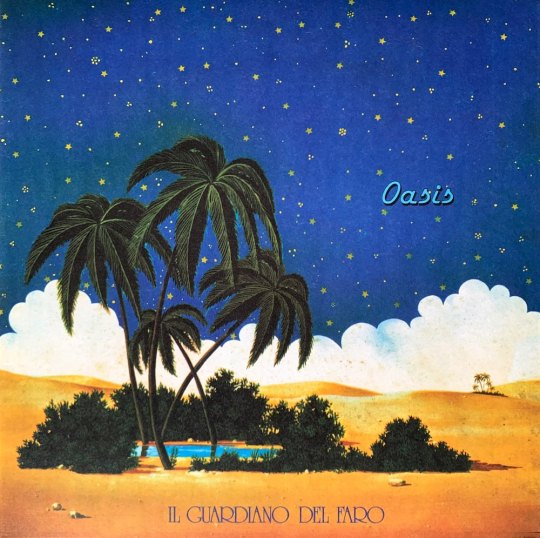
Tulio appears again for “Non una corda al cuore,” which recalls the melodic sunbirth themes from the opening track on wavering Moog fluids that dance and harmonize in the air. Skittering electro-cymbals move beneath vaporous string orchestrations and paradise bass walks until Tulio crashes in with a pounding and regal beat…the soft echoes and reverbs in the mix giving his massive fills a three-dimension quality. Ethereal brass sections play solar spells overhead as the multi-tracked melodies begin ascending ever higher through realms of rainbow luminescence and Federico continues overloading the mix with aching layers of Moog and lustrous piano squiggles while sometimes allowing searing solos to break free from the euphoric haze, their jaw-dropping leads of slow motion majesty wrapping around the towering beats in a way that looks ahead to the earth-shaking power of early 2000s post-rock. Waves of harmonic wonder and sun-soaked melody unite to carry the spirit to impossible heights…the heavenly power bringing tears and stealing breath from the lungs. And Federico is not content to just blow you away with white light power, rather, he insists on completely obliterating the mind and body, leaving nothing behind but pure alchemical essence, which then floats freely upon the plodding drum smashes as everything else is wrapped around by starshine symphonies and hyperreal colorclouds.

“Lady Moon” is one of my favorite discoveries of recent memory…a gorgeous and heart-breaking meditation for the dust-caked western guitar of Johnny Farina. Federico joins in with subdued e-piano mysticisms and ghost organs swell in the background while cold winds blow over expansive desert vistas. A blood red sun descends below the horizon as immersive washes of synthesized light ascend, at times recalling Pink Floyd’s “Welcome to the Machine,” only as if transmuted to faraway lands where cacti reign and lizard and snakes crawl across sun-baked expanses of cracked sand. Johnny’s moody guitar continues holding down a ghost town shuffle while also being nearly overwhelmed by sweltering waves of arid synthesis and overhead, buzzards circle as they await the demise of some tormented soul wandering in desolation. A glowing web of synthesized string beauty initiates “La ragazza che amava il mare e il vento” while soft psychedelic slides and etheric light trails diffuse through swirling phaser clouds. It’s a blissed out ambient utopia of cosmic drama and sea-worn beauty…the title roughly translating to “the girl who loved the wind and sea”…and as the song progresses into a new age fantasia, you can almost feel her deep longing for the salty gales and crashing waves of an ocean of dreams.

Tulio appears one last time in “Disco Divina,” his stoned and spaced out disco groove supported by deep bubbling basslines while hypnotizing washes of cymbal swelling radiance overtake the mix. Outer-dimensional harpsichords bang away and dance through the night with sprightly space leads, while wailing vocal synths evoke a sort of angel opera. Massive tom smashes fly through the air as synths pan and move like intelligent liquids and all the while, the string orchestrations grow increasingly massive and eventually consume the mix with Arabic incantations. As it all comes together, we find ourselves in a faraway mystical land…some sort of camelback adventure on an alien planet where vibed out e-piano fusion solos glide on soul sweeping strings that emanate from the rocks of a mysterious desert palace. We then head further into an Arabic fever dream with “Oasis.” Swinging electro-drums and mystical string melodies waft over wobbling tuba synths that dance through exotic patterns. Splashing toms work around hissing cymbal cascades while the pianos and synths lock together for dueling snake charmer leads…everything eventually giving way to insectoid noises swarming around synth leads that fry the brain. During a jaw-dropping climax, paradise strings grow to epic levels of cosmic wonder…their dreamy exotica and immersive psychedelia evoking Omar Khorshid, only swapping his surf guitars for majestic synthesized symphonies. It’s the sonic equivalent of a sandstorm building in a blood red sky, its gusting winds washing over extra-terrestrial temples while alien druids cast spells against the violent torrents of nature.
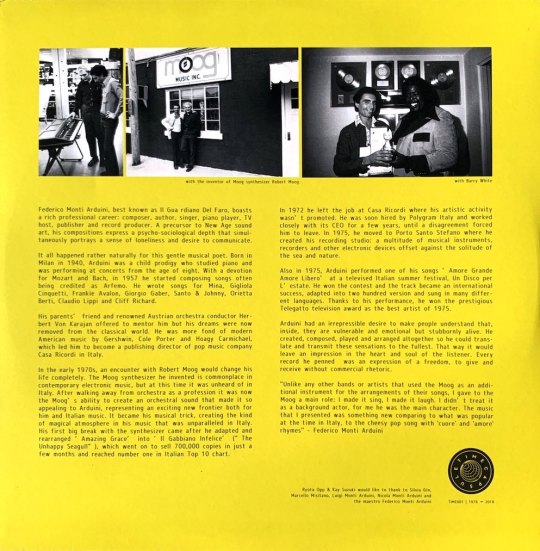
“Immenso mare, immenso amore” provides a welcome come down from the ecstatic adventurism of “Oasis” as it allows us to float gently on a swinging Roland TR-77 shuffle. Tropical hand drums and hissing cymbals glide on aquamarine currents while humid tropical nightscapes are evoked by the gorgeous string synth weavings. Sometimes heatwave blasts of wavering magic flow over the body while at other times aching violins and violas sway together in the moonlight alongside golden piano chords that seem to swim through pools of polychromatic light. The vibrant euphoria continues building as brain-piercing feedback synths solo alongside the sad songs of an interstellar seabird flying alone through a world of dreams. And the melodies are so suffused with warmth and blinding spiritual light as everything moves together for a paradisiacal slow dance upon sea-foam clouds, climaxing with an absolutely maddening synth solo that contrasts the pastoral ambiance and gliding beauty beneath it with atonal liquid fire and mind melting runs up and down the scale, all wild skronking clusters of electronic chaos and fusion explosiveness raining down upon a heart-melting submarine drift.

In “Zenith,” Federico’s amorphous string movements float upon skittering electro-drum propulsion. Imagine fast motion beat hypnotics comprised of tribal toms, wood blocks, and static metal blasts that all fly together on comet tails, resulting in the kind of tripped out machine drum magic associated with 70s krautrock or lofi 90s space rock. Everything in the mix is smothered in echoes and hazy reverb and those scorching harpsichords appear once more to solo over it all…moving through thick puddles of phaser liquids that cling to the futurist tones as they climb towards the heavens. There are haunted space whistles that flow like strands of interstellar gas…as if Alessandro Alessandroni was blasted through a galactic vortex and then allowed to let loose his cinematic western melodies from deep within a dense cloud of pink and blue. And through it all, primordial string orchestrations evoke Kubrick’s “The Dawn of Man” while being intercut with mysterious detective film atmospherics. The “Finale” of Oasis sees a return to the melodies and dream spells of opener “Sinfonia al sole che nasce,” this time with nacreous strands of Rhodes piano floating alone while creating gaseous bass bubbles and meditative vibration waves that shimmer and swirl…giving life and movement to Federico’s daydream melodies for an ethereal coda.
(images from my personal copy)
#il guardiano del faro#federico monti arduini#tulio de piscopo#italy#fusion#ambient#post-classical#new age#balearic#oasis#time capsule#beauty & the beat#kay suzuki#ryota opp#cinematic#moog#string synth#roland tr-77#reel to reel#teac#polymoog#minimoog#tropical#exoitca#arabic#desert#dreamscape#reissue#album reviews#vinyl reviews
3 notes
·
View notes
Text
This will kill That: historical preservation, Victor Hugo, and Notre Dame Cathedral
Early in the novel Notre Dame De Paris by Victor Hugo, Claude Frollo utters this line in seeming agonized frustration, terrifying in its meaning. He directs the eyes of two visitors from a book on his desk to the massive silhouette of Notre Dame cathedral beyond his door, then announces: "This will kill that."
“This” is the book. The arrival of printing, mass produced information and the dissemination of it to the populace, “That” is the cathedral, and all that goes along with it. "Small things overcome great ones," Frollo laments, "the book will kill the building."
For Hugo, the language of mankind to that point has and had been architecture. While the language of the scholar and the educated elite was Latin, the language of the common people was architecture. The grandeur of the cathedral pointed eyes to the glory of heaven, the humbleness of their common dwelling, to the state of man in the sight of his deity.
That language reaches a sort of climax in the Gothic Cathedral and, indeed, the grandeur of Notre Dame. Hugo asserts; in a sort of righteous fervor; that priests had controlled even that language for centuries. From the reflected dogmatic oppression of the squared, Romanesque cathedral, to the flying Gothic architecture that lifts men’s souls, giving wings to poetic liberation with flying buttresses, large stained glass windows, and the awe-inspiring flight of high towers and distant bells.
It is fitting then, that this behemoth of man’s invention and vision should fall to the singular smallness of something so common as movable type. A post-enlightenment sort of David and Goliath. It is fairly easy to see then if we interrogate the style and concepts of this book that Hugo felt architects had nothing left to say. All was neo-this and neo-that, and a sort of re-imagination of the past.
“This” would kill “That.”
And yet, Notre Dame De Paris includes a sort of plea within its pages to acknowledge everything the then-crumbling building represents and to save it from the future ravages of time. By Hugo’s time and the beginning of the research done for the novel, the Cathedral was over 500 years old and had become something of a ruin.
Broken and desecrated after changing governments, lack of repair, and perhaps most notably ravaged by the Huguenots for being idolatrous, AND THEN all the beheading of all the kings of Israel for supposedly being “French Aristocrats and Royalty” during the Revolution, Notre Dame was quite a mess. And, unfortunately, would remain a mess until Hugo could finish the novel; there’s some fun gossip and shade there if you look into the writing-of; and other people began to take interest. This has also been credited as beginning the concept of Historical Preservation, which really only began to take hold in America and the UK post-WW2. (Some people also blame Robert Moses. It sort of depends on your point of view.)
The general theme of the novel is that Notre Dame will and has outlived countless lives of humanity, and all their ineptitude, terrible decisions, and flaws, will pale in comparison to the edifice and it’s lifespan.... should we care to preserve it.
The grand irony, however, is that the book itself became a NEW “This” and was destroyed itself by a new “That” : the advent of movies and hollywood. The story changed, sometimes drastically, cutting and adding characters and changing their motivations, throughout each successor to the story that came before. Frollo became something other than a priest.
Esmeralda went from a white girl stolen by g*psies, to a g*psy herself.
Quasimodo went from deformed man to movie monster to anti hero to protagonist and back again.
Phoebus went from soldier to revolutionary and through some convoluted developments.
Gringoire is left out of most productions post-1930s.
Fleur De Lys often doesn’t feature....
The film has killed the book. This, has killed That. And time marches on.
From Lindsay Ellis: The Case for Disney’s The Hunchback of Notre Dame
From Bartleby:
It was a premonition that human thought, in changing its outward form, was also about to change its outward mode of expression; that the dominant idea of each generation would, in future, be embodied in a new material, a new fashion; that the book of stone, so solid and so enduring, was to give way to the book of paper, more solid and more enduring still. In this respect the vague formula of the Archdeacon had a second meaning—that one Art would dethrone another Art: Printing will destroy Architecture. 4
In effect, from the very beginning of things down to the fifteenth century of the Christian era inclusive, architecture is the great book of the human race, man’s chief means of expressing the various stages of his development, whether physical or mental. 5
When the memory of the primitive races began to be surcharged, when the load of tradition carried about by the human family grew so heavy and disordered that the word, naked and fleeting, ran danger of being lost by the way, they transcribed it on the ground by the most visible, the most lasting, and at the same time most natural means. They enclosed each tradition in a monument. 6
The first monuments were simply squares of rock “which had not been touched by iron,” as says Moses. Architecture began like all writing. It was first an alphabet. A stone was planted upright and it was a letter, and each letter was a hieroglyph, and on every hieroglyph rested a group of ideas, like the capital on the column. Thus did the primitive races act at the same moment over the entire face of the globe. One finds the “upright stone” of the Celts in Asiatic Siberia and on the pampas of America. 7
Presently they constructed words. Stone was laid upon stone, these granite syllables were coupled together, the word essayed some combinations. The Celtic dolmen and cromlech, the Etruscan tumulus, the Hebrew galgal, are words—some of them, the tumulus in particular, are proper names. Occasionally, when there were many stones and a vast expanse of ground, they wrote a sentence. The immense mass of stones at Karnac is already a complete formula. 8
Last of all they made books. Traditions had ended by bringing forth symbols, under which they disappeared like the trunk of a tree under its foliage. These symbols, in which all humanity believed, continued to grow and multiply, becoming more and more complex; the primitive monuments—themselves scarcely expressing the original traditions, and, like them, simple, rough-hewn, and planted in the soil—no longer sufficed to contain them; they overflowed at every point. Of necessity the symbol must expand into the edifice. Architecture followed the development of human thought; it became a giant with a thousand heads, a thousand arms, and caught and concentrated in one eternal, visible, tangible form all this floating symbolism. While Dædalus, who is strength, was measuring; while Orpheus, who is intelligence, was singing—the pillar, which is a letter; the arch, which is a syllable; the pyramid, which is a word, set in motion at once by a law of geometry and a law of poetry, began to group themselves together, to combine, to blend, to sink, to rise, stood side by side on the ground, piled themselves up into the sky, till, to the dictation of the prevailing idea of the epoch, they had written these marvelous books which are equally marvellous edifices: the Pagoda of Eklinga, the Pyramids of Egypt, and the Temple of Solomon. 9
The parent idea, the Word, was not only contained in the foundation of these edifices, but in their structure. Solomon’s Temple, for example, was not simply the cover of the sacred book, it was the sacred book itself. On each of its concentric enclosures the priest might read the Word translated and made manifest to the eye, might follow its transformations from sanctuary to sanctuary, till at last he could lay hold upon it in its final tabernacle, under its most concrete form, which yet was architecture—the Ark. Thus the Word was enclosed in the edifice, but its image was visible on its outer covering, like the human figure depicted on the coffin of a mummy. 10
Again, not only the structure of the edifice but its situation revealed the idea it embodied. According as the thought to be expressed was gracious or sombre, Greece crowned her mountains with temples harmonious to the eye; India disembowelled herself to hew out those massive subterranean pagodas which are supported by rows of gigantic granite elephants. 11
Thus, during the first six thousand years of the world—from the most immemorial temple of Hindustan to the Cathedral at Cologne—architecture has been the great manuscript of the human race. And this is true to such a degree, that not only every religious symbol, but every human thought, has its page and its memorial in that vast book. 12
Every civilization begins with theocracy and ends with democracy.
#Haven Yells About Stuff#Historical Preservation#historical architecture#Notre Dame de Paris#Victor Hugo#a truncated history of things
4 notes
·
View notes
Text
The Edge - A Nalu Fanfiction Chapter 2
Hey everyone!
This is the second chapter to a fantasy AU I wrote for my friend MorriganFae’s Birthday. Take a look if you get the chance ^.^
Cheers,
Satyrykal
Summary:
Link: The Edge
For as long as Lucy can remember, she had been warned about the Others who lived beyond the Edge. Dark and fearsome creatures, the Others are able to enthrall anyone foolish enough to approach them. Then one night, when such a man is dragged beaten and bloodied before her, she can’t help but forget the warnings.
Dark Fantasy Nalu AU based on Beauty & the Beast.
Rated M for mature themes.
Chapter 2 Excerpt:
The first thing she noticed when she opened her eyes was white.
She squinted up at the sheer canopy above her, the long swaths of gauzy lace swaying slightly in the breeze. Lucy groaned, her hand rising to massage her temple at the oncoming headache. She blinked a few times, clearing her vision against the bright sunlight tricking in from all sides. She stretched slightly, her body sinking into the silk sheets whispering against her skin. She burrowed her head further into her down pillow, breathing in the lavender threaded within its feather interior.
She could really use a soak in a warm bath. Her limbs ached while her throat was dry and rattling from the remnants of smoke coating her lungs.
Smoke.
Caramel eyes flashed open as she shot up in bed, ignoring the dull throb webbing against the side of her rib-cage. Her pulse was racing, adrenaline coursing through her as she took in the unfamiliar surroundings. Her spine was stiff as she surveyed the spacious room. She was perched on a pale cedarwood bed, delicate pillars holding up the canopy she'd spotted when she'd first awoken. It was freestanding in the middle of the room. The walls were whitewashed in coastal fashion, the floor covered by a layer of sleek sheepskin, and there were a few other pieces of intricately carved furniture dotting in the space.
Nevertheless, the rich decor was not what first caught her attention. The chamber was semicircular, a sturdy oak door was centered on the straight edge. Along the curve however, were four towering windows that took up much of the remaining space. They were flanked by more lace curtains and were completely open to the elements – not a pane of glass in sight.
It was immediately apparent that the owner of the home was wealthy, and decidedly not from Bosco.
She scrambled out of the blankets, glad for the fleece at her feet when she felt a chill run through her - cool air blowing from outside. She wrapped her arms around herself as she edged towards the windows, her hand shaking slightly was she pulled back the curtain.
Her breath left her all at once.
Beyond the open panes was a straight drop off a vertical slope, no ledge or rail in sight as she scrambled backwards – her heart thundering up to her throat. Her legs wavered at the soaring height as she dropped safely to her knees, taking comfort in the sold marble before she peered back out.
Lucy dragged oxygen through her lungs as she took in the expanse of alabaster cliffs laid out before her. The sun was high in the sky as its light gleamed off the green canopies of the trees punctuated by the rosy hues of late blooming magnolia. The ridges shot up in clumps from the cerulean waves lapping below. The crags were connected by delicate bridges, a shimmering city woven together and hanging among the peaks. With a start she realized the buildings were carved from the rock face, her own pale walls not painted but sculpted straight from raw stone. She let the pads of her fingers brush against the smooth surface, in awe of the craftsmanship of the pillars and the domed ceiling.
How had they managed it? This winding city nestled among the seaside bluffs – the delicate architecture evident all around her – bright and airy and open to the elements. It wasn't just this room either, everywhere she looked had levels of cascading terraces, suspended platforms and gaping windows facing the sharp drops below.
She didn't have to wait long however as her question answered itself.
There didn't seem to be many people out in the early morning, but those who were didn't bother with the roads. Lucy gasped once more as she inched forward. Her gaze flickered up to wispy clouds broken by the gliding figures soaring high above.
End of excerpt.
Read the rest on fanfiction!
#satyrykal#fan fiction#fairy tail#nalu#natsu x lucy#lucy x natsu#lucy heartfilia#natsu dragneel#lucy heartfilia x natsu dragneel#heartfilia#dragneel#heartfilia x dragneel#lucy dragneel#fairy tail fanfiction#fairy tail fandom#dark fantasy#AU#fairy tail au#shameless plug#ff fairy tail#lucy#natsu#my OTP#fairytail otp#dark natsu#END#E.N.D#natsu dragneel x lucy heartfilia#natsu dragon slayer#FT
7 notes
·
View notes